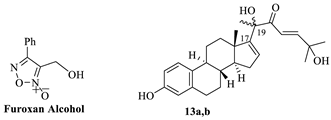Abstract
A new series of nitric oxide-releasing estra-1,3,5,16-tetraene analogs (NO-∆-16-CIEAs) was designed and synthesized as dual inhibitors for EGFR and MRP2 based on our previous findings on estra-1,3,5-triene analog NO-CIEA 17 against both HepG2 and HepG2-R cell lines. Among the target compounds, 14a (R-isomer) and 14b (S-isomer) displayed potent anti-proliferative activity against both HepG2 and HepG2-R cell lines in comparison to the reference drug erlotinib. Remarkably, compound 14a resulted in a prominent reduction in EGFR phosphorylation at a concentration of 1.20 µM with slight activity on the phosphorylation of MEK1/2 and ERK1/2. It also inhibits MRP2 expression in a dose-dependent manner with 24% inhibition and arrested the cells in the S phase of the cell cycle. Interestingly, compound 14a (estratetraene core) exhibited a twofold increase in anti-proliferative activity against both HepG2 and HepG2-R in comparison with the lead estratriene analog, demonstrating the significance of the designed ∆-16 unsaturation. The results shed a light on compound 14a and support further investigations to combat multidrug resistance in chemotherapy of hepatocellular carcinoma patients.
1. Introduction
Hepatocellular carcinoma (HCC) is one of the most frequent and lethal human cancers, and its incidence-to-mortality ratio is rising [1,2,3,4,5,6]. In 2020, HCC represented 2.4% of all new cancer cases and 5.0% of all cancer deaths [4]. The C subset of the human ATP-binding cassette (ABCC) transporters contains a huge group of membrane transport proteins comprising thirteen subfamily members (1–13) and plays a pivotal role in the recognition and transport of most drugs. Among them, the second member of multidrug resistance protein 2 (MRP2) of the MRP subfamily of the encoded ABCC2 gene located on Chromosome 10q23-q24 with a unique amino acid sequence of the ATP-binding domain, which functions properly in drug resistance mechanisms as it is structurally similar to human MRP1 [7]. MRP2 is overexpressed in many cancers such as the liver, kidney, and small intestine to play a key role in the transport of many drugs such as cisplatin, doxorubicin, epirubicin, etoposide, irinotecan, mitoxantrone, methotrexate, SN-38, and Vinca alkaloids, in addition to endogenous metabolites. Korita and co-workers [8] and our research group [9] recently reported that HCC cells produce drug resistance via MRP2 overexpression, which comprises the major problem associated with the available chemotherapeutic agents in 30–80% of cancer patients [10,11]. Furthermore, the EGFR-MEK1/2-ERK1/2 signaling pathway, as well as MRP2, has been validated as effective targets for liver cancer therapy. So far, the discovered agents have revealed significant activity toward MRP1 and P-gp but rarely against MRP2 [8]. Therefore, it is still important to discover a dual inhibitor drug candidate with good efficacy and low toxicity targeting the EGFR-MEK1/2-ERK1/2 signaling pathway as well as MRP2.
It is worth mentioning that the role of NO in cancer therapy is not only that of enhancing tumor blood flow and oxygen supply [12] but also reversing chemotherapy resistance through the upregulation of efflux pumps [13,14]. Along this line of research, Maksimovic-Ivanic et al. demonstrated that the hybridization of some drugs with NO, such as NO-NSAIDs and NO-HIV-PIs, promoted anticancer activity in a wide range of cancer cell lines and in in vivo models, invariably more potent, less toxic, lower dosing, and fewer side effects than the corresponding des-NO analogs [15]. The mode of action is likely multifactorial as they inhibit tumor cell growth, induce apoptosis, exhibit antiangiogenic and antimetastatic activity, and potentially inhibit P-gp-, MRP-1-, and BCRP1-expressing cells making NO-releasing agents as candidates for the treatment of multidrug-resistant tumors [15]. Previously, we detailed the biological studies of NO-releasing cucurbitacin analogs with an estratriene core [16]. Among them, NO-CIEA 17 (Figure 1), exhibits broad-spectrum anti-proliferative activity against both HepG2 and HepG2-R cell lines with IC50 4.69 and 8.21 µM, respectively [16]. Therefore, overcoming the toxicity and cellular resistance problems encouraged us to look for a more active molecular target anticancer agent with nitric oxide-releasing properties for the treatment of HCC.
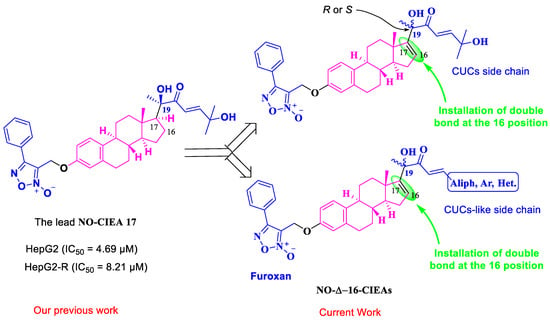
Figure 1.
Design strategy for target compounds NO-∆-16-CIEAs.
Enlightened by the aforementioned and the activity profile displayed by NO-CIEA 17 [16], we explored whether further D-ring modification to rigidify the conformations of the estron skeleton would adopt strong interaction inside the target active sites to obtain the highest potency. To this end, a new series of ∆-16 unsaturated analogs NO-∆-16-CIEAs (Figure 1) was designed, allowing us to establish that the estratetraene core could successfully function as a bioisostere for the estratriene one keeping the NO-releasing furoxan moiety at C-3, Cucurbitacin-like side chain at C-17, and altering the configuration around C-19 in the hope of discovering even more potent compounds.
2. Results and Discussion
2.1. Chemistry
As outlined in Scheme 1, the synthesis of the key intermediate ∆-16-α-hydroxy methyl ketones (11a,b) was started with estrone protection using tert-butyldimethylsilyl chloride (TBSCl) to obtain compound 1, which was then treated with lithium trimethylsilylacetylide to afford a mixture of a ratio about 1:1 of the corresponding propargylic alcohol 2 and 3. These alcohols were deprotected with TBAF (tetra-n-butylammonium fluoride) to form the desired intermediate 17-α-ethynylestradiol 4 in 95.50 % yield [17,18].
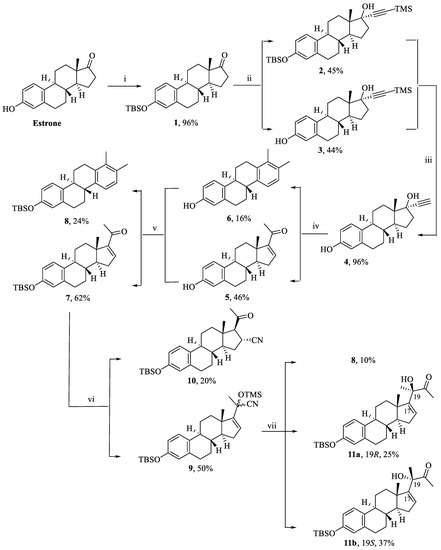
Scheme 1.
Synthesis of key intermediates α-hydroxy methyl ketones 11a,b: (i) TBSCl, imidazole, dry DMF, 12 h; (ii) trimethylsilylacetylene, −20 °C, n-BuLi, 30 min, THF, 0 °C–r.t., 3.5 h; (iii) TBAF, THF, r.t., 12 h; (iv) Cu(OTf)2, dry EtOAc, 100 °C, 4 h; (v) TBSCl, imidazole, dry DMF, 12 h; (vi) TMSCN, ZnI2, THF, −20 °C; (vii) MeLi, Et2O, 0 °C.
Copper triflate (Cu(OTf)2) catalyzed regioselective Markovnikov hydration of 17-α-ethynylestradiol 4 was developed to install the targeted double bond at the 16 position as well as the carbonyl functionality at the C-17 position via Rupe rearrangement. Hassam and Li [19] reported the synthesis of α,β-enone 5 only from the corresponding alkyne 4 using 20 mol% Cu(OTf)2 as a catalyst in ethyl acetate–water mixture under reflux for 2 h. On exposing the catalytic system with one equivalent of Cu(OTf)2 and refluxing in ethyl acetate for 4 h, compound 6 was observed along with α,β-enone 5 in a yield of 15.50 and 46.48%, respectively [20,21,22]. The yield was reversed when the equivalence of Cu(OTf)2 was decreased to 20 mol% in the presence or absence of the catalytic amount of sulfuric acid under reflux. Further, the same results were obtained when the reaction was refluxed and catalyzed with sulfuric acid in either formic or acetic acid. Hence, the formation of aryl derivative 6 is favorable in strong acidic conditions [23]. Furthermore, the crude mixture of α,β-enone 5 and aryl derivative 6 underwent a reaction with TBSCl to protect the phenolic hydroxyl group, hence overcoming the solubility problems through the formation of compounds 7 and 8, respectively.
Compared to other cyano donors, such as acetone cyanohydrin or hydrogen cyanide, TMSCN has the advantage of catalyzing the irreversible addition of CN to the carbonyl electrophile. Furthermore, the large trimethylsilyl group provides some steric hindrance, which can be useful to hold stereopreference for one of the two possible diastereomers [22]. The catalysts used for the addition of TMSCN to α,β-unsaturated enone derivatives, i.e., ZnI2, TiCl4, Yb(OTf)3, LiOEt, Et3N, and 4-DMAP, have previously been shown to catalyze cyanohydrins synthesis [24]. As depicted in Table 1, the addition of TMSCN to the α,β-unsaturated enone 8 was dependent on both the catalyst used and the reaction temperature. Cyanosilylation product 9 (1,2-adduct) is favored at low temperature (−20 °C) in the presence of Lewis acids, either one equivalent ZnI2 or 5 mol% Cu(OTf)2 [25,26]. Conversely, either the neutral (lithium ethoxide) or basic (potassium cyanide in 18-crown-6) catalysts at room temperature were able to promote the cyanation reaction towards the formation of 16-cyano derivative 10 (1,4-adduct). Furthermore, either decreasing the temperature up to −78 °C or proceeding without a catalyst, only resulted in the recovery of unreacted starting material [24,27,28,29,30]. Finally, the enone system (substrate 8) is planar concerning the D-ring and, thus, less constrained by the C-18 methyl group, allowing the approach of the reagent by both sides of the steroid molecule. Consequently, the ZnI2-catalysed addition of TMSCN yielded a mixture of epimeric cyanosilylated product 9 (50% yield), as observed by NMR, as well as 16-α-cyano analog 10 (20% yield) [24]. This lack of chemo selectivity in the ZnI2-catalysed TMSCN addition was not surprising. In fact, although the reported ZnI2 catalyzed 1,2-addition to conjugated enones, 1,4-addition was also noticed [24].

Table 1.
Addition of TMSCN to α,β-enone 8.
More specifically, the assignment of the 16-configuration of the cyano group was made based on the 1H NMR anisotropic shielding effect of this functional group toward the 18-CH3, which appears as a singlet peak at 0.42 ppm, in contrast with 0.73 ppm in the starting compound 8. Such an effect suggests that the methyl group is positioned in the conical area of the cyano substituent. In agreement with this observation, the coupling constant of the doublet due to the 17-H (2.79 ppm) is relatively high, J = 8.7 Hz, pointing to a trans-vicinal coupling with the 16-H (3.41 ppm) [24].
Moreover, the mixture of the key intermediate 11a and 11b was isolated from the reaction of epimeric cyanosilylated 9 with methyl lithium in ether at 0 °C. This diastereomeric mixture with ∆Rf equal to 0.1 was then separated by column chromatography (5% ethyl acetate in hexane) and, then, identified as (19R)-α-hydroxy methyl ketone (11a, 24.72% yield) and (19S)-α-hydroxy methyl ketone (11b, 36.78% yield). The assignment of the C-19 configuration of the hydroxyl group was made on the basis of 1H NMR and 13C NMR chemical shifts in this functional group as well as X-ray crystallographic analysis (Figure 2), and these data were compared to a CUCs side chain containing the function group reported previously by our research group [31]. 1H NMR showed a singlet signal at 4.07 ppm and 3.90 ppm corresponding to 11a and 11b, respectively. Surprisingly, the protected α,β-enone 8 was also detected in the mixture in 10.20% yield with an unknown mechanism.
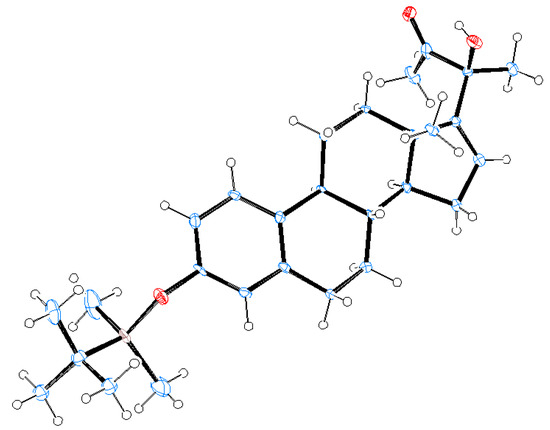
Figure 2.
X-ray crystal structure of 11a showing the R-configuration around C-19 [31].
As illustrated in Scheme 2, the precursor 2-((tert-butyldimethylsilyl)oxy)-2-methylpropanal was synthesized as reported [31] and subjected to aldol condensation with the key intermediates α-hydroxymethylketones 11a,b using LDA to afford the desired cucurbitacin-inspired estra-1,3,5,16-tetraene analogs 12a,b. Then, they underwent deprotection to provide the phenolic derivatives 13a,b, which were coupled with furoxan mesylate [16,32] to afford the target cucurbitacin-inspired estra-1,3,5,16-tetraene furoxan analogs (NO-CIETA) 14a,b.
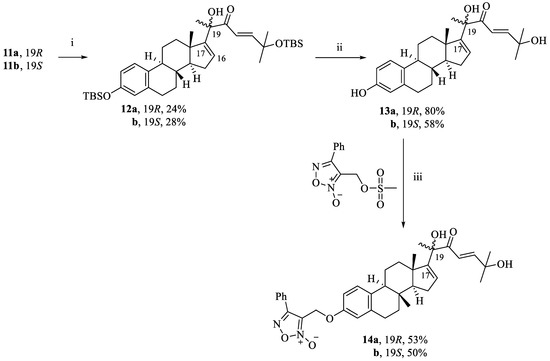
Scheme 2.
Synthesis of NO-∆-16-CIEAs 14a,b: (i) LDA, THF, −78 °C, 1 h, 2-((tert-butyldimethylsilyl)oxy)-2-methylpropanal, −78 °C to r.t., 20 h; (ii) TBAF, THF, r.t., 12 h; (iii) NaOH, THF, 3-(((methylsulfonyl)oxy)methyl)-4-phenyl-1,2,5-oxadiazole 2-oxide, reflux, 2 h.
For more study about the SAR, the key intermediates α-hydroxymethylketones 11a,b were then reacted with aromatic or heterocyclic aldehydes through aldol condensation and in situ elimination using NaOH to afford cucurbitacin-inspired estra-1,3,5,16-tetraene analogs 15a–j. Deprotection and finally coupling with furoxan mesylate provided the target compounds 17a–j, Scheme 3.
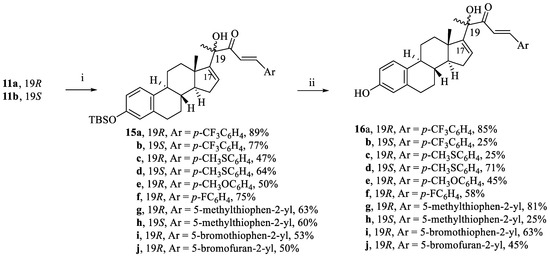
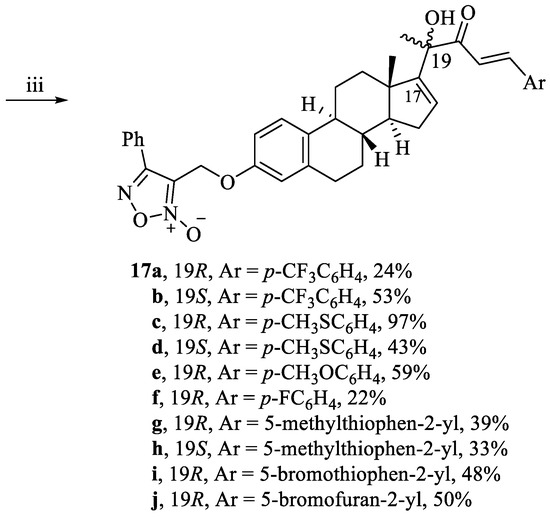
Scheme 3.
Synthesis of NO-∆-16-CIEA with aromatic/heterocyclic side chains: (i) ArCHO, NaOH, THF, 105 °C, 10–30 min; (ii) TBAF, THF, r.t., 12 h; (iii) 3-(((methylsulfonyl)oxy)methyl)-4-phenyl-1,2,5-oxadiazole 2-oxide, NaOH, THF, reflux, 2 h.
There are some attempts to improve the yield percentages for the target compounds; among them, deprotection of 11b with TBAF and then O-alkylation with furoxan mesylate followed by aldol condensation with different aromatic or heterocyclic aldehydes to afford the desired compounds 20a–d, as described in Scheme 4.
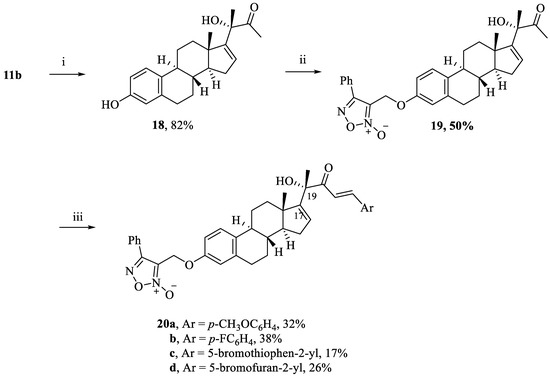
Scheme 4.
Modified pathway for the preparation of some target compounds: (i) TBAF, THF, r.t., 12 h; (ii) 3-(((methylsulfonyl)oxy)methyl)-4-phenyl-1,2,5-oxadiazole 2-oxide, NaOH, THF, reflux, 2 h. (iii) ArCHO, NaOH, THF, 105 °C, 10–30 min.
2.2. Biological Activity
2.2.1. In Vitro Anti-Proliferative Activity
The target compounds 14a,b, 17a–j, and 20a–d were examined for their in vitro anti-proliferative activity against HepG2 and HepG2-R (erlotinib-resistant [9]) liver cell lines. The cells were treated with serial dilutions of test compounds for 48 h, after which the cell viability was determined by a standard MTT colorimetric assay, using erlotinib as a reference drug.
As shown in Table 2, the results against HepG2 cells indicated that compound 14a (IC50 = 2.40 ± 0.44 µM) was found to be the most potent analog among the tested compounds, being ten times more active than the reference drug erlotinib. Moreover, compounds 14b and 17a possessed higher anti-proliferative activities than the reference drug with IC50 8.10 ± 0.92 and 9.44 ± 0.44 µM, respectively. In addition, compounds 17g and 17h were almost equipotent to erlotinib with IC50 24.00 ± 3.80 and 25.00 ± 3.12 µM, respectively. Furthermore, compounds 17b–f, 17i, 17j, and 20a–d did not inhibit the proliferation of HepG2 cells at concentrations as high as 50 µM. Moreover, compounds linked with an aromatic or heterocyclic side chain at the C-17 position dramatically dropped or totally abolished the anticancer activity unlike compound 14a.

Table 2.
Anticancer activity of the NO-∆-16-CIEA 14a,b, 17a–j, and 20a–d in human cancer cell lines.
Then, our attention was directed to screen our designed compounds against the HepG2-R cell line. The data revealed that analogs with cucurbitacin side chain 14a and 14b only have a potent cytotoxicity activity (IC50 3.74 ± 0.66 µM and 6.47 ± 1.41 µM, respectively). Therefore, they may have a good impact on chemotherapeutic resistance.
Our consideration was then extended to examine the effect of compiling the furoxan ring with the estrone core as two pharmacophoric features. Accordingly, NO-releasing furoxan alcohol and cucurbitacin steroidal phenolic derivative 13a and 13b were examined (Table 3). The data revealed that compound 13a showed IC50 18.87 ± 2.40 and 24.22 ± 0.72 µM in HepG2 and HepG2-R cells, respectively, while compounds furoxan alcohol and 13b did not inhibit the proliferation of both cell lines at concentrations as high as 50 µM. The results indicated that sp2-hybridization favored anticancer activity and consequently improved the anti-proliferative activity of estratetraene derivative dramatically by blocking the estrogenic activity [34] of C3 phenolic hydroxy.

Table 3.
Anticancer activity of the ∆-16-CIEA 13a,b and furoxan alcohol in HepG2 and HepG2-R cell lines.
Furthermore, some important physicochemical parameters were calculated to examine the drug-likeness properties of these compounds [35]. The lipophilicity parameter indicated by CLogP and the polar surface area (PSA) was estimated. As shown in Table 2, compounds 14a and 14b possesses good CLogP (6.39) and PSA (118.25) values among the target final analogs.
2.2.2. Structure-Activity Relationships (SARs) Study
Substitution at CUCs aromatic-like side chain with either electron-withdrawing (EWG) CF3 and Br (i.e., compounds 17b, 17i,j, and 20c,d) or electron-donating (EDG) CH3S and CH3O groups, as in compounds 17c–e and 20a, had no significant effect on the anticancer activity. Notably, the EWG group F substitution at the CUCs aromatic-like side chain (i.e., compound 20b) may impact the activity. In contrast, CF3 substitution caused compound 17a to exhibit significant inhibitory effects in its anticancer activity, indicating that the electron-withdrawing substituents likely led to enhanced potency. On the other hand, replacing both EDG and EWG with a polar t-BuOH group caused compounds 14a and 14b to exhibit significant inhibitory effects in their anticancer activity, indicating that appending the CUCs side chain at C-17 likely led to enhanced potency. Furthermore, the results showed a significant improvement in anticancer activity, especially for compounds 14a and 14b, compared to des-NO-releasing compounds 13a and 13b indicating synergistic efficiency.
It is worth mentioning that the configuration around the C-19 played a crucial role in the biological activity among the most active compounds. Particularly, compound 14a with R-configuration showed higher activity than the corresponding S-isomer 14b in both HepG2 and HepG2-R cell lines. Moreover, compound 17a with R configuration around C-19 showed a potent cytotoxicity activity against the HepG2 cell line while the corresponding S-isomer 17b was inactive up to 50 µM. In addition, the anticancer activity showed a twofold increase against both the HepG2 and HepG2-R cell lines when the estratriene core in NO-CIEA I was replaced with estratetraene core in compound 14a, demonstrating the significance of ∆-16 unsaturation. Appending the furoxan moiety at C3, and utilizing the CUCs side chain at C-17, ring D unsaturation at C-16, and R configuration around C-19 can be suggested as vital elements for the growth inhibitory activity of the hybrids reported here, see Figure 3. In this context, the synthesized analogs are considered promising candidates for the treatment of HCC and overcoming the chemotherapeutic resistance.
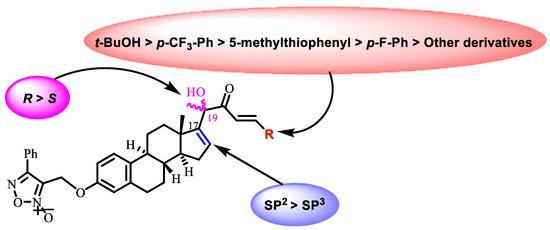
Figure 3.
SAR of target compounds.
2.2.3. Cell-Based ELISA
As compound 14a showed a good profile of anti-proliferative activity against both HepG2 and HepG2-R cancer cell lines, the study was extended to explore its mode of action using the In-cell Western assay (ICW). As shown in Figure 4, the Odyssey image shows the detection of total proteins regardless of phosphorylation status as well as the detection of decreasing amounts of phospho-protein as a function of increasing 14a concentrations, while the graphical representations show the quantification of fluorescence. The data reveal the slight activity for compound 14a after incubation for 24 h at a concentration of 4.80 µM to inhibit the phosphorylation of MEK1/2 and ERK1/2 (≈10% and 12% inhibition, respectively) compared to untreated cells (Control), whereas no effects were observed for phosphorylated EGFR. Surprisingly, 14a resulted in a significant reduction in EGFR phosphorylation in treated cells at a concentration of 1.20 µM with 43% inhibition. Furthermore, as shown in Figure 4, there is a significant reduction in MRP2 expression in the HepG2-R cell line [36] caused by compound 14a in a dose-dependent manner with 24% inhibition compared to control, demonstrating a significant impact on the chemotherapeutic resistance.
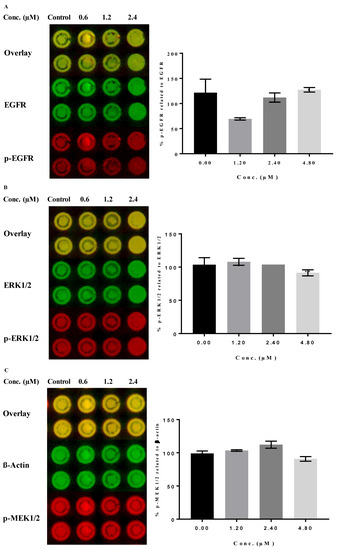
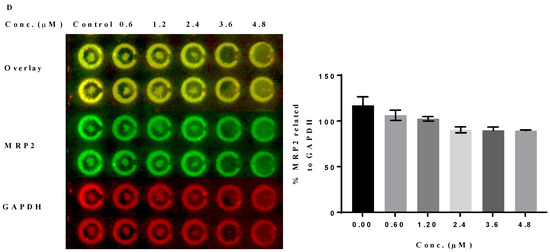
Figure 4.
In-Cell Western analysis of predicted protein targets of NO-∆-16-CIEA 14a: (A) Analysis of EGFR phosphorylation in HepG2 cells; ICW plate image and p-EGFR intensity in 800 channel was normalized to total EGFR intensity in 700 channel. (B) Analysis of ERK1/2 phosphorylation in HepG2 cells; ICW plate image and p-ERK1/2 intensity in 800 channel was normalized to total ERK1/2 intensity in 700 channel. (C) Analysis of MEK1/2 phosphorylation in HepG2 cells; ICW plate image and p-MEK1/2 intensity in 700 channel was normalized to β-actin intensity in 800 channel. (D) Analysis of MRP2 inhibition in HepG2-R cells; ICW plate image and MRP2 intensity in 800 channel was normalized to GAPDH intensity in 700 channel. Values reported are averages ± SD of at least two measurements.
2.2.4. Flow Cytometric Study
After the 24 h incubation of compounds 14a (2.4 μM) and 14b (8.1 μM) and vehicle DMSO as the control, quantitation of the results showed that 14a exhibited a decrease in the fraction of cells in the G0/G1 phase (34.66% compared to 44.11% for the control) and an increase in the proportion of cells in the S phase (59.05 % compared to 48.82%) and the G2/M phase (6.29% compared to 7.06%) (Figure 5A,B). Moreover, compound 14b also exhibited an increase in the fraction of cells in the G2/M phase (17.08% compared to 7.06% for the control) and a decrease in the proportion of cells in the S phase (39.99% compared to 48.82%) and the G0/G1 phase (42.93% compared to 44.11%) (Figure 5A,C). Therefore, compound 14a arrested the cells in the S phase while 14b arrested the cells in the G2/M phase of the cell cycle.
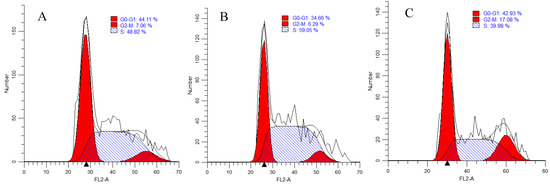
Figure 5.
Flow cytometric analysis of cell cycle parameters: HepG2 liver cancer cells were incubated for 24 h; (A) control; (B) 2.4 µM (IC50) of NO-∆-16-CIEA 14a; (C) 8.1 µM (IC50) of NO-∆-16-CIEA 14b.
2.2.5. NO Detection
The levels of NO produced intracellularly from compounds 14a,b and 17a along with JS-K (a known NO donor prodrug) were examined using NO-sensitive fluorophore DAF-FM DA, (Figure 6A–D). It was observed that compound 14a showed a significant increase in fluorescence (2.9-fold compared to untreated cells) after 6 h of incubation in a dose-dependent manner and produced amounts of NO in tumor cells comparable to JS-K [16], which also showed a significant increase in fluorescence (2.9-fold compared to untreated cells) after 1 h of incubation in a dose-dependent manner. It was also found that compounds 14b and 17a showed a relative increase in fluorescence by about 1.38 and 1.13-fold compared to untreated cells (Control) after 1 h and 6 h of incubation in a dose-dependent manner, respectively. Furthermore, these results strongly suggest that compound 14a is a far superior source of controlled NO release in comparison with the reference prodrug JS-K.
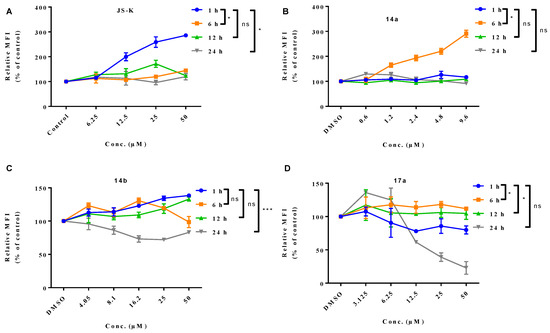
Figure 6.
Intracellular NO release in HepG2 as measured by DAF-FM DA assay: (A) JS-K (reference prodrug); (B) NO-∆-16-CIEA 14a; (C) NO-∆-16-CIEA 14b; (D) NO-∆-16-CIEA 17a. Values reported are averages ± SD of at least two measurements. * p ≤ 0.05, *** p ≤ 0.001, ns: nonsignificant.
Additionally, compound 14a was tested again for its NO-releasing activity in the HepG2-R cell line and the data revealed a marked increase in fluorescence intensity after incubation for 6 h with concentrations lower than the IC50. Moreover, treatment with higher concentrations than IC50 or a prolonged incubation showed a marked decrease in fluorescence intensity in a dose-dependent manner compared to the DMSO control (Figure 7). Therefore, the potent inhibitory effects of compound 14a might be related to the obvious release of NO, estratetraene skeleton, and the absolute configuration of C-19 in the cucurbitacin side chain.
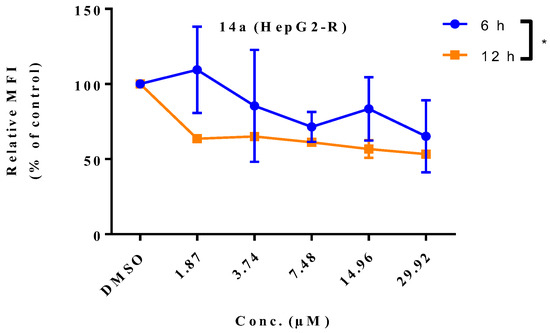
Figure 7.
Intracellular NO release of NO-∆-16-CIEA 14a in HepG2-R as measured by DAF-FM DA assay. Values reported are averages ± SD of at least two measurements. * p ≤ 0.05.
It is worth mentioning that our previously reported lead furoxan hybrid NO-CIEA 17 with IC50 values of 4.69 and 8.21 µM against both HepG2 and HepG2-R cell lines, respectively, showed an increase in fluorescence after 1 h of incubation in a dose-dependent manner and produced a significant concentration of NO in tumor cells compared to JS-K (reference drug). In addition, NO-CIEA 17 released a maximum level of NO at a concentration of 32.92 and 25 µM compared to the reference prodrug JS-K, which produced the maximum release at 50 µM.
In addition, in a dose-dependent manner, the tested compounds showed a marked decrease in NO level compared to the DMSO control after incubation for 24 h. The incubation of cells with the target compounds decreased the overall metabolic activity of the cells, as determined by MTT assay within the concentration range and incubation periods tested; thus, the low NO intracellular content at high concentrations of NO donors was caused by their cytotoxicity activity. Moreover, the DAF-FM DA probe was sufficient for detecting the increased fluorescence within a wide range of NO concentrations, as shown by the measurements after 1 h of incubation. These findings document that any potential quenching of the specific DAF-FM DA fluorescence after incubation for long periods by increased NO production at higher concentrations of the tested compound did not happen.
As a result, the NO-releasing activity showed an increase in fluorescence after 6 h of incubation with NO-∆16-CIEA 14a (IC50: HepG2 = 2.40 µM; HepG2-R = 3.74 µM) in a dose-dependent manner, while the lead compound NO-CIEA 17 (IC50: HepG2 = 4.69 µM; HepG2-R = 8.21 µM) was, after 1 h, demonstrating the significance of ∆-16 unsaturation and controlled NO release.
2.3. Molecular Docking Studies
2.3.1. Lead-Optimization and Library Design
The lead compound NO-CIEA 17, in our previous work [16], was used for the efficient design of potent molecules using OpenEye’s EON software in lead optimization and library design. EON calculates the electrostatic similarity between the designed compounds and the existing lead compound, NO-CIEA 17, in the form of an Electrostatic Tanimoto (ET) score [37]. The lower EON-ranked compounds have the highest shape and electrostatic similarity to the reference, as shown in Table 4.

Table 4.
EON results of shape and electrostatic similarity between the designed compounds and the query NO-CIEA 17.
2.3.2. Structure-Based Design
A molecular docking study was carried out to examine the binding modes of the designed compounds in the active sites of EGFR (PDB:ID 1M17), ERK2 (PDB:ID 5NHJ), MEK1 (PDB:ID 1S9J), and MRP1 (PDB:ID 2CBZ) using the OpenEye Scientific software [38], as shown in Table 5. Among the docked compounds, 14a scored the best Chemgauss4 scores within the target active sites [39]. As shown in Figure 8A, the FRED view of compound 14a inside EGFR active site showed an overlay with the co-crystallized ligand erlotinib in addition to the inverted binding mode to the lead NO-CIEA I with three hydrogen bonding formations between (1) C-19-OH and a hydroxyl group of THR:830:A with bond length of 1.54 Å, (2) C23-OH and a hydroxyl group of THR:766:A with bond length of 2.22 Å, and (3) C23-OH and a carbonyl group of LEU:764:A with bond length of 1.59 Å. Inside the active site of both ERK2 and MEK1, compound 14a scored the highest Chemgauss4 overlaying with the co-crystallized ligands with hydrophobic interactions as shown in Figure 8B,C, respectively. In the active site of MRP1, the compound 14a showed an overlay with the adenosine moiety of the ATP ligand, forming a hydrogen bond coming from C23-OH and the hydroxyl group of THR:666:A with bond length of 1.91 Å (Figure 8D).

Table 5.
FRED Chemgauss4 score for the designed compounds, lead compound NO-CIEA 17 and erlotinib docked with EGFR, MEK1, Erk2, and MRP1 protein active sites.
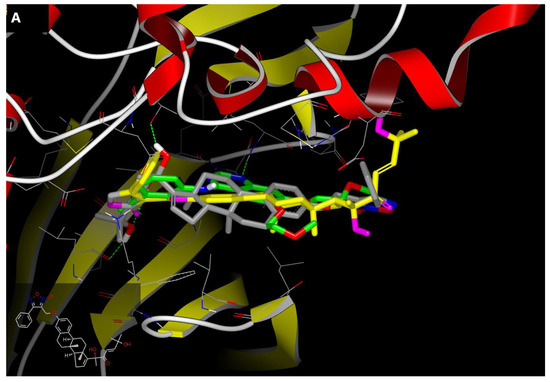
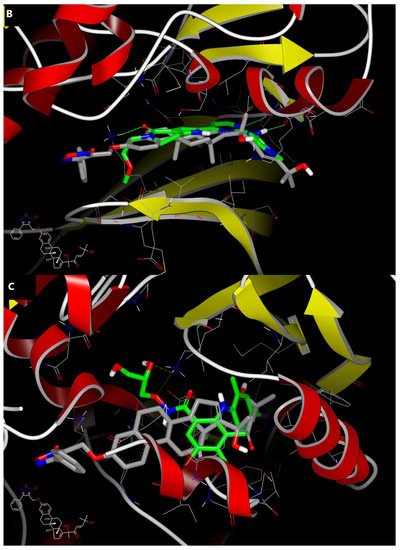

Figure 8.
Visual representation for (A) erlotinib (green), 14a (grey), and NO-CIEA I (yellow) overlay docked with EGFR showing hydrophobic–hydrophobic interactions and hydrogen bonds (green dash lines) towards ATP-binding site, (B) overlay of 14a (grey) and co-crystallized ligand (green) docked with Erk2 showing hydrophobic–hydrophobic interactions, (C) overlay of 14a (gray), and co-crystallized ligand (green) docked with MEK1 showing hydrophobic–hydrophobic interactions, (D) overlay of 14a (gray) and co-crystallized ligand (green) docked with MRP1 showing hydrophobic–hydrophobic interactions and hydrogen bonds (green dash line) towards the active site.
As a result, the rigidification of the D-ring through the installation of a double bond at C-16, particularly in compound 14a with R-configuration around C-19, improved the binding affinity toward the tested protein active sites, which might serve as a good candidate for EGFR-ERK signal transduction inhibitors.
3. Materials and Methods
3.1. General Chemical Techniques
1H and 13C NMR spectra were acquired on a Bruker AVANCE-400 or 600 MHz NMR spectrometer, in DMSO-d6, CDCl3, or (CD3)2CO using the solvent residual peak as the internal standard, with the reporting of coupling constants in Hz and the signal multiplicities are reported as singlet (s), doublet (d), triplet (t), quartet (q), doublet of doublets (dd), doublet of triplets (dt), multiplet (m), or broad (br). HRMS data were obtained using EI ionization on a ThermoFinnigan MAT 95 XL mass spectrometer at Buffalo mass spectroscopy facility, Buffalo, NY, USA. TLC analysis was performed using pre-coated silica gel PE sheets. Products were purified via column chromatography using silica gel 40–63 um (230–400 mesh) and prep-plates (Alltech preparative column, Econosil C18 10u, length 250 mm, ID 22 mm). All reagents and solvents were obtained from commercial suppliers and used as received. All chemical reactions requiring anhydrous conditions were performed with oven-dried glassware under an atmosphere of nitrogen.
Compounds 1,2 [40], 3 [17], 4 [18,41,42], 5 [19,43], and 6 [23] were prepared as reported.
3.1.1. General Procedure A for C3 Phenolic OH Protection
To a stirred solution of crude mixture of phenolic enones 5 and 6 (0.51 mmol) in DMF (1.5 mL), imidazole (0.092 g, 1.35 mmol) and TBSCl (0.113 g, 0.75 mmol) were added. The reaction mixture was stirred for 12 h at room temperature then extracted with ethyl acetate (3 × 10 mL) and evaporated to give a brown oil. Column chromatography (10–30% ethyl acetate in hexane) was used to purify the crude products, which gives the target enone tert-butyldimethylsilyl ether 7 (62.20 %) as a white powder in addition to the side product 8 (24.15 %) as a white powder [23,44,45].
3.1.2. General Procedure B for Cyanosilylation
To a stirred solution of enone 7 (0.131 g, 0.32 mmol) in dry dichloromethane (DCM) (1 mL) at −20 °C, TMSCN (0.053 mL, 0.42 mmol) and zinc iodide (0.102 g, 0.32 mmol) were added. The reaction mixture was stirred for 2 h at −20 °C then concentrated in vacuo. To the concentrated slurry, water was added, and then the aqueous layer was extracted using ethyl acetate (3 × 10 mL), dried over anhydrous sodium sulfate, and concentrated in vacuo. The crude product was purified using silica gel column chromatography (1% ethyl acetate in hexane) to give (0.108 g, 66.18 %) a mixture of diastereomers 9 (50 %) in the ratio about 1:0.5 (NMR detection), and a side product 16-cyano derivative 10 (20 %) as white powders [26,29].
3.1.3. General Procedure C for Preparation of the Key Intermediated α-Hydroxy Ketones
To a stirred solution of diastereomers 9 (0.54 g, 1.06 mmol) in a dry diethyl ether (3.10 mL), methyl lithium (2.00 mL, 3.19 mmol) was added drop wise at 0 °C. The reaction mixture was stirred for 2 h at 0 °C, and then quenched by adding glacial acetic acid (0.40 mL) in one portion at 0 °C and allowed to stir for 30 min at 0 °C. Saturated sodium bicarbonate solution was added to neutralize the acidic mixture, and the aqueous layer was extracted by ethyl acetate (3 × 50 mL), dried under anhydrous sodium sulfate, and then concentrated under vacuo. The resulting crude products were separated by silica gel column chromatography (5% ethyl acetate in hexane) to give the hydroxyl methyl ketones 11a (25%) and 11b (37%) and the side product 8 (10.20%) [26].
3.1.4. General Procedure D for Preparation of C-17 CUCs Side Chain Precursors
To a stirred solution of α-hydroxy ketone 11a,b (0.500 g, 0.79 mmol) in THF (1.6 mL), LDA (1.42 mL, 2.83 mmol, 2 M in THF) was added at −78 °C and stirred for 1 h. A solution of 2-((tert-butyldimethylsilyl)oxy)-2-methylpropanal (0.3997 g, 1.98 mmol) in THF (5.3 mL) was then added at −78 °C, and the reaction mixture was allowed to slowly warm to room temperature and stirred for 20 h. The reaction mixture was then quenched by the addition of saturated NH4Cl (20 mL), followed by extraction with EtOAc (3 × 50 mL), dried over anhydrous sodium sulfate, and concentrated in vacuo. The crude product was purified by silica gel column chromatography with hexanes/EtOAc (9.5:0.5) to yield the desired products 12a,b.
3.1.5. General Procedure E for Aldol Condensation
In an open 20 mL glass vial, aromatic aldehyde derivatives (1.5 mmol) and NaOH (2.9 mmol) were added to a solution of hydroxyl methyl ketone 11a,b and 19 (1 mmol) in 1 mL dry THF. The reaction mixture was heated at 110 °C for 10–45 min and THF was continuously added at a rate of ~0.5 mL per 1 min till the completion of the reaction (monitored by TLC). The reaction mixture was quenched with water and then the aqueous layer was extracted using ethyl acetate (3 × 10 mL), dried over anhydrous sodium sulfate, and concentrated under vacuo. The crude product was then purified using silica gel column chromatography (5% ethyl acetate in hexane) to yield enone products 15a–j and NO-CIETA 20a–d in good yields [46,47].
3.1.6. General Procedure F for Deprotection
To a stirred solution of protected enone 12a,b, 15a–j, and 11b (1 mmol) in THF (3 mL), TBAF (3.1 mmol) was added and stirred for 12 h. The reaction mixture was quenched with saturated ammonium chloride solution and then extracted with ethyl acetate (3 × 20 mL), dried over sodium sulfate anhydrous, filtrated, and concentrated in vacuo. Silica gel column chromatography was used to purify the crude material (15 % ethyl acetate in hexane) to afford NO-CIETA 13a,b, 16a–j, and 18 [18].
3.1.7. General Procedure G for Coupling with Furoxan
To a stirred solution of the respective enone, 13a,b, 16a–j, and 18 (0.28 mmol) in THF (3 mL), furoxan mesylate (0.150 g, 0.56 mmol) and sodium hydroxide (0.011 g, 0.28 mmol) were added. The reaction mixture was heated under reflux for 1 h, then another 0.011 g (0.28 mmol) of sodium hydroxide was added and the reflux was continued for another 1 h (TLC monitoring). The reaction mixture was quenched with water and extracted with ethyl acetate (3 × 10 mL), dried over sodium sulfate anhydrous, filtrated, and concentrated under vacuo. Silica gel column chromatography was used to purify the crude material (10% ethyl acetate in hexane) to afford the titled NO-CIETA 14a,b, 17a–j, and 19.
3.2. Chemical Synthesis and Characterization
1-((8S,9S,13S,14S)-3-((tert-butyldimethylsilyl)oxy)-13-methyl-7,8,9,11,12,13,14,15-octahydro-6H-cyclopenta[a]phenanthren-17-yl)ethenone (7). Following general procedure, A, compounds 6 and 5 (0.51 mmol) were protected with TBSCl (0.113 g, 0.75 mmol). White powder; 62% yield; 1H NMR (400 MHz, CDCl3) δ 6.92 (d, J = 8.4 Hz, 1H), 6.53 (dd, J = 3.3, 1.8 Hz, 1H), 6.42 (dd, J = 8.4, 2.5 Hz, 1H), 6.36 (d, J = 2.5 Hz, 1H), 2.72–2.52 (m, 2H), 2.35–2.30 (m, 1H), 2.22–2.12 (m, 2H), 2.08 (s, 3H), 1.96–1.89 (m, 1H), 1.73–1.67 (m, 1H), 1.46–1.07 (m, 6H), 0.79 (s, 9H), 0.73 (s, 3H), 0.00 (s, 6H).13C NMR (101 MHz, CDCl3) δ 196.72, 155.57, 153.35, 144.34, 137.58, 133.19, 125.94, 119.97, 117.21, 55.67, 46.53, 44.33, 36.97, 34.86, 32.03, 29.49, 27.84, 27.17, 26.43, 25.78, 18.21, 15.99, −4.32. 13C DEPT135-NMR (151 MHz, CDCl3) δ 144.31, 125.93, 119.95, 117.19, 55.68, 44.32, 36.97, 34.84 (inverted), 32.02 (inverted), 29.47 (inverted), 27.82 (inverted), 27.17, 26.40 (inverted), 25.74, 15.97, −4.36.
Tert-butyl(((4bS,10bR)-7,8-dimethyl-4b,5,6,10b,11,12-hexahydrochrysen-2-yl)oxy)dimethylsilane (8). Following general procedure, A, compound 8 was obtained as a side product. White powder; 24% yield; 1H NMR (600 MHz, CDCl3) δ 7.04 (d, J = 8.4 Hz, 1H), 7.00 (d, J = 8.0 Hz, 1H), 6.84 (d, J = 8.0 Hz, 1H), 6.47 (dd, J = 8.4, 2.6 Hz, 1H), 6.42 (d, J = 2.6 Hz, 1H), 2.83–2.70 (m, 3H), 2.69–2.61 (m, 1H), 2.52–2.38 (m, 4H), 2.09 (s, 3H), 1.98 (s, 3H), 1.50–1.42 (m, 2H), 0.79 (s, 9H), 0.00 (s, 6H). 13C NMR (151 MHz, CDCl3) δ 211.42, 138.18, 137.99, 135.29, 134.77, 133.95, 133.03, 127.32, 126.42, 122.91, 119.83, 117.37, 41.54, 39.90, 30.20, 28.28, 27.90, 25.75, 20.45, 18.22, 15.12, 1.05, −4.34. 13C DEPT135-NMR (151 MHz, CDCl3) δ 127.32, 126.42, 122.91, 119.83, 117.37, 41.54, 39.90, 30.20 (inverted), 28.28 (inverted), 27.90 (inverted), 27.84 (inverted), 25.75, 20.46, −4.34.
2-((8S,9S,13S,14S)-3-((tert-butyldimethylsilyl)oxy)-13-methyl-7,8,9,11,12,13,14,15-octahydro-6H-cyclopenta[a]phenanthren-17-yl)-2-((trimethylsilyl)oxy)propanenitrile (9). Following general procedure, B, compound 7 was cyanosilylated. White powder; 50% yield; 1H NMR (400 MHz, CDCl3) δ 6.91 (d, J = 8.4 Hz, 1H), 6.42 (dd, J = 8.4, 2.5 Hz, 1H), 6.37 (d, J = 2.5 Hz, 1H), 5.74–5.70 (m, 1H), 2.68–2.60 (m, 2H), 2.17–1.97 (m, 3H), 1.84–1.67 (m, 2H), 1.58 (s, 3H), 1.51–1.00 (m, 6H), 0.84 (s, 3H), 0.79 (s, 9H), 0.08 (s, 9H), 0.00 (s, 6H). 13C NMR (101 MHz, CDCl3) δ 152.97, 152.88, 151.95, 136.27, 131.68, 126.52, 126.30, 124.39, 120.36, 120.19, 118.57, 115.74, 70.99, 68.03, 67.26, 56.23, 56.03, 46.16, 45.65, 42.61, 42.35, 35.65, 34.18, 33.59, 30.54, 29.39, 29.22, 29.11, 28.99, 28.32, 28.05, 26.16, 25.00, 24.91, 24.32, 21.31, 16.76, 16.01, 15.94, 12.75, 0.17, 0.00, −0.37, −5.78.
(8S,9S,13S,14S)-17-acetyl-3-((tert-butyldimethylsilyl)oxy)-13-methyl-7,8,9,11,12,13,14,15,16,17-decahydro-6H-cyclopenta[a]phenanthrene-16-carbonitrile (10). Following general procedure, B, compound 10 was obtained as a side product. White powder; 20% yield; 1H NMR (400 MHz, CDCl3) δ 6.91 (d, J = 8.5 Hz, 1H), 6.44 (dd, J = 8.5, 2.4 Hz, 1H), 6.37 (d, J = 2.4 Hz, 1H), 3.41 (ddd, J = 11.6, 8.7, 2.9 Hz, 1H), 2.79 (d, J = 8.7 Hz, 1H), 2.65–2.60 (m, 2H), 2.21–2.08 (m, 2H), 2.04 (s, 3H), 2.00–1.94 (m, 1H), 1.65–1.53 (m, 3H), 1.37–1.21 (m, 3H), 0.79 (s, 9H), 0.42 (s, 3H), 0.00 (s, 6H). 13C NMR (101 MHz, CDCl3) δ 204.72, 153.62, 137.47, 131.92, 126.02, 123.40, 120.09, 117.42, 69.03, 54.88, 45.31, 43.34, 38.52, 38.26, 31.11, 30.40, 29.36, 27.49, 26.27, 25.74, 25.38, 18.20, 13.43, −4.35. HRESI-MS m/z calcd for [M + H]+ C27H39NO2Si: 460.264227, found: 460.265381.
(R)-3-((8S,9S,13S,14S)-3-((tert-butyldimethylsilyl)oxy)-13-methyl-7,8,9,11,12,13,14,15-octahydro-6H-cyclopenta[a]phenanthren-17-yl)-3-hydroxybutan-2-one (11a). Following general procedure, C, R-isomer 11a was obtained. White powder; 25% yield; 1H NMR (400 MHz, CDCl3) δ 6.88 (d, J = 8.5 Hz, 1H), 6.41 (dd, J = 8.5, 2.5 Hz, 1H), 6.36 (d, J = 2.5 Hz, 1H), 5.71 (dd, J = 3.1, 1.3 Hz, 1H), 4.07 (s, 1H), 2.73–2.57 (m, 2H), 2.08−2.05 (m, 1H), 2.03 (s, 3H), 1.89–1.82 (m, 1H), 1.73–1.70 (m, 2H), 1.43–1.34 (m, 2H), 1.33 (s, 3H), 1.23–1.98 (m, 5H), 0.83 (s, 3H), 0.79 (s, 9H), 0.00 (s, 6H). 13C NMR (101 MHz, CDCl3) δ 211.12, 155.63, 153.34, 137.70, 133.16, 128.82, 125.85, 119.98, 117.14, 79.55, 57.56, 47.81, 44.15, 37.06, 34.52, 31.08, 29.53, 27.68, 26.23, 25.77, 25.32, 23.32, 18.20, 17.28, −4.34.
(S)-3-((8S,9S,13S,14S)-3-((tert-butyldimethylsilyl)oxy)-13-methyl-7,8,9,11,12,13,14,15-octahydro-6H-cyclopenta[a]phenanthren-17-yl)-3-hydroxybutan-2-one (11b). Following general procedure, C, S-isomer 11b was obtained. White powder; 37% yield; 1H NMR (400 MHz, CDCl3) δ 6.90 (d, J = 8.6 Hz, 1H), 6.42 (dd, J = 8.4, 2.6 Hz, 1H), 6.36 (d, J = 2.4 Hz, 1H), 5.72–5.70 (m, 1H), 3.90 (s, 1H), 2.71–2.57 (m, 2H), 2.11–2.07 (m, 1H), 2.05 (s, 3H), 1.82–1.76 (m, 2H), 1.72–1.65 (m, 2H), 1.55–1.48 (m, 2H), 1.37 (s, 3H), 1.28–1.03 (m, 4H), 0.79 (s, 9H), 0.59 (s, 3H), 0.00 (s, 6H). 13C NMR (101 MHz, CDCl3) δ 210.99, 155.56, 153.32, 137.69, 133.22, 128.78, 125.86, 119.97, 117.15, 80.09, 56.73, 48.14, 43.93, 37.15, 36.20, 31.06, 29.49, 27.67, 26.46, 25.75, 24.92, 23.74, 18.20, 17.00, −4.35.
(R,E)-6-((tert-butyldimethylsilyl)oxy)-2-((8S,9S,13S,14S)-3-((tert-butyldimethylsilyl)oxy)-13-methyl-7,8,9,11,12,13,14,15-octahydro-6H-cyclopenta[a]phenanthren-17-yl)-2-hydroxy-6-methylhept-4-en-3-one (12a). Following general procedure, D, compound 11a (0.500 g, 0.79 mmol) was used as a starting material. White powder; 24% yield; 1H NMR (600 MHz, CDCl3) δ 6.88 (dd, J = 15.1, 8.4 Hz, 2H), 6.55 (d, J = 15.1 Hz, 1H), 6.41 (dd, J = 8.4, 2.4 Hz, 1H), 6.37 (d, J = 2.4 Hz, 1H), 5.73 (d, J = 1.9 Hz, 1H), 4.21 (s, 1H), 2.72–2.58 (m, 2H), 2.06–1.97 (m, 2H), 1.94–1.85 (m, 2H), 1.74–1.62 (m, 2H), 1.44–1.32 (m, 3H), 1.30 (s, 3H), 1.17, 1.16 (two s, 6H), 1.11–0.97 (m, 2H), 0.84 (s, 3H), 0.79 (s, 9H), 0.73 (s, 9H), 0.00 (s, 6H), −0.08 (s, 6H). 13C NMR (151 MHz, CDCl3) δ 203.99, 158.57, 157.14, 155.36, 139.78, 135.22, 131.33, 127.85, 122.03, 120.90, 119.15, 80.53, 75.64, 59.60, 49.57, 46.30, 39.02, 36.17, 33.07, 31.90, 31.53, 29.69, 28.18, 27.87, 27.78, 27.25, 20.23, 19.35, 0.00, −0.04, −2.33.
(S,E)-6-((tert-butyldimethylsilyl)oxy)-2-((8S,9S,13S,14S)-3-((tert-butyldimethylsilyl)oxy)-13-methyl-7,8,9,11,12,13,14,15-octahydro-6H-cyclopenta[a]phenanthren-17-yl)-2-hydroxy-6-methylhept-4-en-3-one (12b). Following general procedure, D, compound 11b (0.500 g, 0.79 mmol) was used as a starting material. White powder; 28% yield; 1H NMR (600 MHz, CDCl3) δ 6.90 (d, J = 8.5 Hz, 1H), 6.85 (d, J = 15.1 Hz, 1H), 6.53 (d, J = 15.1 Hz, 1H), 6.42 (dd, J = 8.5, 2.5 Hz, 1H), 6.36 (d, J = 2.5 Hz, 1H), 5.73 (d, J = 1.8 Hz, 1H), 4.12 (s, 1H), 2.71–2.57 (m, 2H), 2.11–2.00 (m, 3H), 1.80–1.66 (m, 4H), 1.55–1.50 (m, 1H), 1.34 (s, 3H), 1.30–1.19 (m, 2H), 1.17 (s, 3H), 1.14 (s, 3H), 1.08–1.06 (m, 1H), 0.79 (s, 9H), 0.73 (s, 9H), 0.53 (s, 3H), 0.00 (s, 6H), −0.07, −0.09 (two s, 6H). 13C NMR (151 MHz, CDCl3) δ 203.67, 157.94, 157.51, 155.36, 139.80, 135.41, 131.26, 127.95, 122.03, 121.46, 119.19, 81.27, 75.63, 58.90, 50.15, 46.05, 39.24, 38.44, 33.10, 31.94, 31.75, 31.59, 29.76, 28.55, 27.90, 27.83, 27.14, 20.30, 20.28, 19.30, 0.00, −0.02, −2.29.
(R,E)-2,6-dihydroxy-2-((8S,9S,13S,14S)-3-hydroxy-13-methyl-7,8,9,11,12,13,14,15-octahydro-6H-cyclopenta[a]phenanthren-17-yl)-6-methylhept-4-en-3-one (13a). Following general procedure, F, compound 12a (0.636 g, 1 mmol) was deprotected using TBAF (3.1 mL, 3.1 mmol). White powder; 80% yield; 1H NMR (600 MHz, Acetone) δ 7.81 (s, 1H), 6.97 (d, J = 15.4 Hz, 1H), 6.90 (d, J = 8.4 Hz, 1H), 6.65 (d, J = 15.5 Hz, 1H), 6.44 (dd, J = 8.4, 2.6 Hz, 1H), 6.38 (d, J = 2.6 Hz, 1H), 5.83 (dd, J = 3.3, 1.5 Hz, 1H), 4.33 (s, 1H), 3.97 (s, 1H), 2.71–2.59 (m, 2H), 2.12–2.04 (m, 2H), 1.97–1.87 (m, 3H), 1.77–1.71 (m, 2H), 1.44–1.39 (m, 1H), 1.32 (s, 3H), 1.24–1.20 (m, 1H), 1.19 (s, 3H), 1.18 (s, 3H), 1.16–1.12 (m, 2H), 0.87 (s, 3H). 13C NMR (151 MHz, Acetone) δ 202.03, 156.66, 156.60, 155.98, 138.35, 132.09, 129.19, 126.76, 120.04, 116.01, 113.58, 79.41, 70.84, 58.17, 48.44, 45.04, 38.28, 35.15, 31.65, 30.27, 29.50, 28.48, 27.16, 25.89, 17.65.
(S,E)-2,6-dihydroxy-2-((8S,9S,13S,14S)-3-hydroxy-13-methyl-7,8,9,11,12,13,14,15-octahydro-6H-cyclopenta[a]phenanthren-17-yl)-6-methylhept-4-en-3-one (13b). Following general procedure, F, compound 12b (0.636 g, 1 mmol) was deprotected using TBAF (3.1 mL, 3.1 mmol). White powder; 58% yield; 1H NMR (600 MHz, Acetone) δ 7.80 (s, 1H), 6.92 (dd, J = 15.6, 8.4 Hz, 2H), 6.69 (d, J = 15.6 Hz, 1H), 6.45 (dd, J = 8.4, 2.6 Hz, 1H), 6.39 (d, J = 2.6 Hz, 1H), 5.73 (dd, J = 3.2, 1.4 Hz, 1H), 4.26 (s, 1H, C-19-OH), 3.92 (s, 1H), 2.70–2.59 (m, 2H), 2.16–2.04 (m, 2H), 1.93–1.82 (m, 3H), 1.78–1.73 (m, 1H), 1.63–1.58 (m, 1H), 1.51–1.46 (m, 1H), 1.43–1.37 (m, 1H), 1.35 (s, 3H), 1.31–1.21 (m, 2H), 1.18 (s, 3H), 1.17 (s, 3H), 0.69 (s, 3H). 13C NMR (151 MHz, Acetone) δ 201.24, 157.05, 155.98, 155.48, 138.35, 132.18, 128.38, 126.76, 120.89, 116.00, 113.57, 79.99, 70.76, 57.93, 48.72, 44.96, 38.35, 36.94, 31.58, 30.26, 29.49, 28.51, 27.35, 25.71, 17.65.
3-((((8S,9S,13S,14S)-17-((R,E)-2,6-dihydroxy-6-methyl-3-oxohept-4-en-2-yl)-13-methyl-7,8,9,11,12,13,14,15-octahydro-6H-cyclopenta[a]phenanthren-3-yl)oxy)methyl)-4-phenyl-1,2,5-oxadiazole 2-oxide (14a). Following general procedure, G, compound 13a (0.115 g, 0.28 mmol) was alkylated with furoxan mesylate. Yellowish green powder; 53% yield; 1H NMR (600 MHz, CDCl3) δ 7.78 (d, J = 7.0 Hz, 2H), 7.50–7.42 (m, 3H), 7.10–7.06 (two d, J = 8.6, 15.4 Hz, 2H), 6.70 (dd, J = 8.6, 2.7 Hz, 1H), 6.64 (d, J = 2.7 Hz, 1H), 6.58 (d, J = 15.4 Hz, 1H), 5.87 (d, J = 1.8 Hz, 1H), 4.98 (s, 2H), 4.31 (s, 1H), 2.84–2.72 (m, 2H), 2.20–1.95 (m, 4H), 1.86–1.77 (m, 2H), 1.55–1.49 (m, 2H), 1.43 (s, 3H), 1.32 (s, 3H), 1.31 (s, 3H), 1.24–1.07 (m, 3H), 0.94 (s, 3H). 13C NMR (151 MHz, CDCl3) δ 201.54, 157.16, 155.30, 154.85, 154.84, 138.48, 134.64, 131.36, 129.48, 129.35, 128.62, 127.77, 126.42, 126.25, 118.77, 114.93, 112.25, 78.63, 71.32, 58.30, 57.39, 47.70, 44.10, 36.94, 34.28, 31.10, 29.64, 29.50, 29.46, 27.46, 26.18, 25.20, 17.25. 13C DEPT135-NMR (151 MHz, CDCl3) δ 155.31, 131.37, 129.49, 129.36, 127.77, 126.43, 118.76, 114.93, 112.25, 58.29 (inverted), 57.38, 44.10, 36.94, 34.28 (inverted), 31.10 (inverted), 29.64 (inverted), 29.51, 27.46 (inverted), 26.18 (inverted), 25.19, 17.24. HRESI-MS m/z calcd for [M + Na]+ C35H40N2O6: 607.277858, found: 607.279321.
3-((((8S,9S,13S,14S)-17-((S,E)-2,6-dihydroxy-6-methyl-3-oxohept-4-en-2-yl)-13-methyl-7,8,9,11,12,13,14,15-octahydro-6H-cyclopenta[a]phenanthren-3-yl)oxy)methyl)-4-phenyl-1,2,5-oxadiazole 2-oxide (14b). Following general procedure, G, compound 13b (0.115 g, 0.28 mmol) was alkylated with furoxan mesylate. Yellowish green powder; 50% yield; 1H NMR (600 MHz, CDCl3) δ 7.82–7.76 (m, 2H), 7.50–7.41 (m, 3H), 7.12 (d, J = 8.6 Hz, 1H), 7.05 (d, J = 15.4 Hz, 1H), 6.70 (dd, J = 8.6, 2.7 Hz, 1H), 6.64 (d, J = 2.7 Hz, 1H), 6.58 (d, J = 15.4 Hz, 1H), 5.86 (dd, J = 3.1, 1.3 Hz, 1H), 4.99 (s, 2H), 4.17 (s, 1H), 2.84–2.74 (m, 2H), 2.20–2.16 (m, 2H), 1.94–1.86 (m, 2H), 1.84–1.77 (m, 2H), 1.65–1.51 (m, 2H), 1.47 (s, 3H), 1.36–1.33 (m, 1H), 1.31 (s, 3H), 1.28 (s, 3H), 1.24–1.18 (m, 2H), 0.64 (s, 3H). 13C NMR (151 MHz, CDCl3) δ 201.30, 157.16, 155.24, 154.84, 154.73, 138.45, 134.74, 131.36, 129.35, 129.19, 127.77, 126.47, 126.25, 119.37, 114.90, 112.26, 112.24, 79.17, 71.24, 58.30, 56.74, 48.06, 43.90, 37.08, 36.19, 31.08, 29.61, 29.47, 29.34, 27.48, 26.46, 24.93, 17.34. 13C DEPT135-NMR (151 MHz, CDCl3) δ 154.74, 131.36, 129.35, 129.20, 127.77, 126.48, 119.36, 114.89, 112.25, 58.29 (inverted), 56.74, 43.89, 37.08, 36.19 (inverted), 31.08 (inverted), 29.62 (inverted), 29.34, 27.48 (inverted), 26.46 (inverted), 24.92, 17.34. HRESI-MS m/z calcd for [M + Na]+ C35H40N2O6: 607.277858, found: 607.279500.
(R,E)-4-((8S,9S,13S,14S)-3-((tert-butyldimethylsilyl)oxy)-13-methyl-7,8,9,11,12,13,14,15-octahydro-6H-cyclopenta[a]phenanthren-17-yl)-4-hydroxy-1-(4-(trifluoromethyl)phenyl)pent-1-en-3-one (15a). Following general procedure, E, compound 11a (0.455 g, 1 mmol) underwent aldol condensation using p-trifluoromethylbenzaldehyde (0.261 g, 1.5 mmol). White powder; 89% yield; 1H NMR (400 MHz, CDCl3) δ 7.68 (d, J = 15.9 Hz, 1H), 7.57–7.45 (m, 4H), 6.92 (d, J = 15.9 Hz, 1H), 6.86 (d, J = 8.4 Hz, 1H), 6.41 (dd, J = 8.4, 2.5 Hz, 1H), 6.36 (d, J = 2.5 Hz, 1H), 5.86 (d, J = 1.7 Hz, 1H), 4.23 (s, 1H), 2.73–2.56 (m, 2H), 2.16–2.09 (m, 1H), 2.04–1.88 (m, 2H), 1.74–1.71 (m, 2H), 1.48–1.43 (m, 1H), 1.41 (s, 3H), 1.38–0.97 (m, 5H), 0.88 (s, 3H), 0.79 (s, 9H), 0.00 (s, 6H). 13C NMR (101 MHz, CDCl3) δ 200.70, 155.16, 153.29, 142.93, 137.70, 133.15, 132.12, 129.75, 128.80, 125.99, 125.81, 122.40, 121.10, 119.94, 117.09, 78.79 (C-19-OH), 57.53, 47.85, 43.98, 37.03, 34.50, 31.24, 29.50, 27.60, 26.19, 25.72, 25.25, 18.18, 17.25, −4.38.
(S,E)-4-((8S,9S,13S,14S)-3-((tert-butyldimethylsilyl)oxy)-13-methyl-7,8,9,11,12,13,14,15-octahydro-6H-cyclopenta[a]phenanthren-17-yl)-4-hydroxy-1-(4-(trifluoromethyl)phenyl)pent-1-en-3-one (15b). Following general procedure, E, compound 11b (0.455 g, 1 mmol) underwent aldol condensation using p-trifluoromethylbenzaldehyde (0.261 g, 1.5 mmol). White powder; 77% yield; 1H NMR (400 MHz, CDCl3) δ 7.64 (d, J = 15.8 Hz, 1H), 7.53–7.43 (m, 4H), 6.91 (dd, J = 15.8, 8.4 Hz, 2H), 6.42 (dd, J = 8.4, 2.5 Hz, 1H), 6.37 (d, J = 2.5 Hz, 1H), 5.82 (d, J = 1.8 Hz, 1H), 4.01 (s, 1H), 2.69–2.63 (m, 2H), 2.14–2.03 (m, 3H), 1.85–1.67 (m, 2H), 1.60–1.49 (m, 1H), 1.43 (s, 3H), 1.40–1.03 (m, 5H), 0.79 (s, 9H), 0.59 (s, 3H), 0.00 (s, 6H). 13C NMR (101 MHz, CDCl3) δ 200.40, 155.57, 153.35, 142.32, 137.68, 133.17, 132.08, 129.31, 128.69, 125.96, 125.92, 125.86, 121.87, 119.97, 117.15, 79.38, 56.92, 48.16, 43.96, 37.19, 31.98, 29.76, 29.72, 29.42, 25.73, 22.74, 18.18, 17.54, 14.16, −4.38.
(R,E)-4-((8S,9S,13S,14S)-3-((tert-butyldimethylsilyl)oxy)-13-methyl 7,8,9,11,12,13,14,15-octahydro-6H-cyclopenta[a]phenanthren-17-yl)-4-hydroxy-1-(4-(methylthio)phenyl)pent-1-en-3-one (15c). Following general procedure, E, compound 11a (0.455 g, 1 mmol) underwent aldol condensation using 4-(methylthio)benzaldehyde (0.228 g, 1.5 mmol). Yellow powder; 47% yield; 1H NMR (400 MHz, CDCl3) δ 7.63 (d, J = 15.8 Hz, 1H), 7.32 (d, J = 8.4 Hz, 2H), 7.06 (d, J = 8.4 Hz, 2H), 6.86 (d, J = 8.4 Hz, 1H), 6.80 (d, J = 15.8 Hz, 1H), 6.40 (dd, J = 8.4, 2.5 Hz, 1H), 6.36 (d, J = 2.5 Hz, 1H), 5.83 (s, J = 1.7 Hz, 1H), 4.34 (s, 1H), 2.73–2.56 (m, 2H), 2.32 (s, 3H), 2.14–2.08 (m, 1H), 2.03–1.86 (m, 2H), 1.75–1.68 (m, 2H), 1.46–1.44 (m, 1H), 1.39 (s, 3H), 1.35–1.09 (m, 5H) 0.87 (s, 3H), 0.79 (s, 9H), 0.00 (s, 6H). 13C NMR (101 MHz, CDCl3) δ 200.85, 155.52, 153.25, 144.46, 143.16, 137.72, 133.29, 130.74, 129.24, 129.09, 125.90, 125.84, 119.92, 117.70, 117.07, 78.56, 57.44, 47.81, 43.96, 37.05, 34.38, 31.21, 29.53, 27.62, 26.22, 25.75, 25.47, 18.19, 17.28, 15.08, −4.35.
(S,E)-4-((8S,9S,13S,14S)-3-((tert-butyldimethylsilyl)oxy)-13-methyl-7,8,9,11,12,13,14,15-octahydro-6H-cyclopenta[a]phenanthren-17-yl)-4-hydroxy-1-(4-(methylthio)phenyl)pent-1-en-3-one (15d). Following general procedure, E, compound 11b (0.455 g, 1 mmol) underwent aldol condensation using 4-(methylthio)benzaldehyde (0.228 g, 1.5 mmol). Yellow powder; 64% yield; 1H NMR (600 MHz, CDCl3) δ 7.60 (d, J = 15.7 Hz, 1H), 7.30 (d, J = 8.4 Hz, 2H), 7.05 (d, J = 8.4 Hz, 2H), 6.91 (d, J = 8.5 Hz, 1H), 6.79 (d, J = 15.7 Hz, 1H), 6.42 (dd, J = 8.5, 2.6 Hz, 1H), 6.36 (d, J = 2.6 Hz, 1H), 5.80 (dd, J = 3.2, 1.4 Hz, 1H), 4.17 (s, 1H), 2.69–2.60 (m, 2H), 2.32 (s, 3H), 2.12–2.04 (m, 3H), 1.87–1.79 (m, 2H), 1.71–1.69 (m, 2H), 1.57–1.52 (m, 1H), 1.42 (s, 3H), 1.31–1.20 (m, 2H), 1.08 (s, 1H), 0.79 (s, 9H), 0.57 (s, 3H), 0.00 (s, 6H). 13C NMR (151 MHz, CDCl3) δ 200.66, 155.87, 153.31, 143.90, 143.03, 137.72, 133.29, 130.79, 129.00, 128.94, 125.93, 125.87, 119.95, 118.46, 117.12, 79.13, 56.92, 48.15, 43.96, 37.17, 36.28, 31.15, 29.50, 27.67, 26.47, 25.75, 25.18, 18.20, 17.51, 15.10, −4.35.
(R,E)-4-((8S,9S,13S,14S)-3-((tert-butyldimethylsilyl)oxy)-13-methyl-7,8,9,11,12,13,14,15-octahydro-6H-cyclopenta[a]phenanthren-17-yl)-1-(4-methoxyphenyl)-4-hydroxypent-1-en-3-one (15e). Following general procedure, E, compound 11a (0.455 g, 1 mmol) underwent aldol condensation using 4-methoxybenzaldehyde (0.204 g, 1.5 mmol). White powder; 50% yield; 1H NMR (600 MHz, CDCl3) δ 7.65 (d, J = 15.7 Hz, 1H), 7.38 (d, J = 8.8 Hz, 2H), 6.86 (d, J = 8.5 Hz, 1H), 6.76 (d, J = 8.8 Hz, 2H), 6.73 (d, J = 15.7 Hz, 1H), 6.40 (dd, J = 8.5, 2.5 Hz, 1H), 6.36 (d, J = 2.5 Hz, 1H), 5.82 (d, J = 1.8 Hz, 1H), 4.38 (s, 1H), 3.68 (s, 3H), 2.71–2.56 (m, 2H), 2.12–2.08 (m, 1H), 2.02–1.85 (m, 3H), 1.74–1.66 (m, 2H), 1.45–1.41 (m, 1H), 1.38 (s, 3H), 1.37–1.31 (m, 2H), 1.23–1.16 (m, 1H), 1.10–1.02 (m, 1H), 0.88 (s, 3H), 0.79 (s, 9H), 0.00 (s, 6H). 13C NMR (151 MHz, CDCl3) δ 200.87, 162.04, 155.65, 153.24, 144.77, 137.73, 133.32, 130.58, 129.05, 127.08, 125.84, 119.90, 117.05, 116.46, 114.49, 78.46, 57.40, 55.47, 47.80, 43.95, 37.06, 34.33, 31.18, 29.53, 27.61, 26.21, 25.73, 25.53, 18.18, 17.26, −4.37.
(R,E)-4-((8S,9S,13S,14S)-3-((tert-butyldimethylsilyl)oxy)-13-methyl-7,8,9,11,12,13,14,15-octahydro-6H-cyclopenta[a]phenanthren-17-yl)-1-(4-fluorophenyl)-4-hydroxypent-1-en-3-one (15f). Following general procedure, E, compound 11a (0.455 g, 1 mmol) underwent aldol condensation using 4-fluorobenzaldehyde (0.186 g, 1.5 mmol). White powder; 75% yield; 1H NMR (600 MHz, CDCl3) δ 7.64 (d, J = 15.8 Hz, 1H), 7.43–7.38 (m, 2H), 6.96–6.91 (m, 2H), 6.86 (d, J = 8.4 Hz, 1H), 6.78 (d, J = 15.8 Hz, 1H), 6.40 (dd, J = 8.4, 2.6 Hz, 1H), 6.36 (d, J = 2.6 Hz, 1H), 5.83 (dd, J = 3.2, 1.4 Hz, 1H), 4.29 (s, 1H), 2.70–2.58 (m, 2H), 2.13–2.09 (m, 1H), 2.02–1.88 (m, 3H), 1.73–1.69 (m, 2H), 1.45–1.41 (m, 1H), 1.39 (s, 3H), 1.36–1.34 (m, 1H), 1.23 –1.04 (m, 3H), 0.88 (s, 3H), 0.79 (s, 9H), −0.00 (s, 6H). 13C NMR (151 MHz, CDCl3) δ 200.80, 155.41, 153.27, 143.65, 137.70, 133.22, 130.72, 130.66, 129.37, 125.80, 119.91, 118.52, 117.07, 116.30, 116.16, 78.61, 57.48, 47.83, 43.98, 37.04, 34.41, 31.20, 29.50, 27.61, 26.19, 25.71, 25.37, 18.17, 17.25, −4.38.
(R,E)-4-((8S,9S,13S,14S)-3-((tert-butyldimethylsilyl)oxy)-13-methyl-7,8,9,11,12,13,14,15-octahydro-6H-cyclopenta[a]phenanthren-17-yl)-4-hydroxy-1-(5-methylthiophen-2-yl)pent-1-en-3-one (15g). Following general procedure, E, compound 11a (0.455 g, 1 mmol) underwent aldol condensation using 5-methylthiophene-2-carbaldehyde (0.189 g, 1.5 mmol). Yellow powder; 63% yield; 1H NMR (600 MHz, CDCl3) δ 7.69 (d, J = 15.4 Hz, 1H), 6.99 (d, J = 3.6 Hz, 1H), 6.86 (d, J = 8.5 Hz, 1H), 6.57 (dd, J = 3.6, 1.1 Hz, 1H,), 6.48 (d, J = 15.4 Hz, 1H), 6.40 (dd, J = 8.5, 2.5 Hz, 1H), 6.36 (d, J = 2.5 Hz, 1H), 5.80 (dd, J = 3.2, 1.4 Hz, 1H), 4.33 (s, 1H), 2.71–2.56 (m, 2H), 2.34 (s, 3H), 2.12–2.08 (m, 1H), 2.01–1.86 (m, 3H), 1.73–1.66 (m, 2H), 1.43–1.38 (m, 1H), 1.36 (s, 3H), 1.24–1.02 (m, 4H), 0.86 (s, 3H), 0.79 (s, 9H), −0.00 (s, 6H). 13C NMR (151 MHz, CDCl3) δ 200.63, 155.50, 153.24, 145.39, 137.90, 137.74, 137.66, 133.59, 133.33, 129.12, 127.03, 125.84, 119.90, 117.05, 116.41, 78.37, 57.39, 47.77, 43.97, 37.06, 34.32, 31.17, 29.54, 27.62, 26.21, 25.73, 25.53, 18.18, 17.25, 15.97, −4.37.
(S,E)-4-((8S,9S,13S,14S)-3-((tert-butyldimethylsilyl)oxy)-13-methyl-7,8,9,11,12,13,14,15-octahydro-6H-cyclopenta[a]phenanthren-17-yl)-4-hydroxy-1-(5-methylthiophen-2-yl)pent-1-en-3-one (15h). Following general procedure, E, compound 11b (0.455 g, 1 mmol) underwent aldol condensation using 5-methylthiophene-2-carbaldehyde (0.189 g, 1.5 mmol). Yellow powder; 60% yield; 1H NMR (400 MHz, CDCl3) δ 7.66 (d, J = 15.4 Hz, 1H), 6.97 (d, J = 3.6 Hz, 1H), 6.91 (d, J = 8.5 Hz, 1H), 6.56 (dd, J = 3.6, 1.1 Hz, 1H), 6.47 (d, J = 15.4 Hz, 1H), 6.42 (dd, J = 8.5, 2.4 Hz, 1H), 6.36 (d, J = 2.4 Hz, 1H), 5.83–5.75 (m, 1H), 4.19 (s, 1H), 2.70–2.58 (m, 2H), 2.33 (s, 3H), 2.13–2.00 (m, 3H), 1.87–1.78 (m, 2H), 1.75–1.67 (m, 2H), 1.57–1.50 (m, 1H), 1.39 (s, 3H), 1.30–1.03 (m, 3H), 0.79 (s, 9H), 0.57 (s, 3H), 0.00 (s, 6H). 13C NMR (151 MHz, CDCl3) δ 200.42, 155.85, 153.29, 145.26, 137.90, 137.74, 137.20, 133.52, 133.32, 128.88, 127.01, 125.87, 119.94, 117.13, 117.10, 78.96, 56.90, 48.14, 43.96, 37.16, 36.30, 31.13, 29.51, 27.67, 26.46, 25.74, 25.25, 18.19, 17.46, 15.96, −4.36.
(R,E)-1-(5-bromothiophen-2-yl)-4-((8S,9S,13S,14S)-3-((tert-butyldimethylsilyl)oxy)-13-methyl-7,8,9,11,12,13,14,15-octahydro-6H-cyclopenta[a]phenanthren-17-yl)-4-hydroxypent-1-en-3-one (15i). Following general procedure, E, compound 11a (0.455 g, 1 mmol) underwent aldol condensation using 5-bromothiophene-2-carbaldehyde (0.286 g, 1.5 mmol). Yellow powder; 53% yield; 1H NMR (600 MHz, CDCl3) δ 7.63 (d, J = 15.4 Hz, 1H), 6.92 (d, J = 3.9 Hz, 1H), 6.87–6.85 (m, 2H), 6.51 (d, J = 15.4 Hz, 1H), 6.40 (dd, J = 8.5, 2.6 Hz, 1H), 6.36 (d, J = 2.6 Hz, 1H), 5.80 (dd, J = 3.2, 1.3 Hz, 1H), 4.23 (s, 1H), 2.72–2.55 (m, 2H), 2.12- 2.08 (m, 1H), 2.02–1.85 (m, 3H), 1.74–1.65 (m, 2H), 1.44–1.38 (m, 1H), 1.36 (s, 3H), 1.34–1.32 (m, 1H), 1.20–1.01 (m, 3H), 0.86 (s, 3H), 0.79 (s, 9H), 0.00 (s, 6H). 13C NMR (151 MHz, CDCl3) δ 200.46, 155.24, 153.27, 141.38, 137.74, 136.24, 133.25, 132.97, 131.45, 129.50, 125.82, 119.93, 117.98, 117.15, 117.07, 78.53, 57.47, 47.80, 43.98, 37.05, 34.42, 31.21, 29.52, 27.60, 26.21, 25.74, 25.39, 18.19, 17.24, −4.36.
(R,E)-1-(5-bromofuran-2-yl)-4-((8S,9S,13S,14S)-3-((tert-butyldimethylsilyl)oxy)-13-methyl-7,8,9,11,12,13,14,15-octahydro-6H-cyclopenta[a]phenanthren-17-yl)-4-hydroxypent-1-en-3-one (15j). Following general procedure, E, compound 11a (0.455 g, 1 mmol) underwent aldol condensation using 5-bromofuran-2-carbaldehyde (0.261 g, 1.5 mmol). Yellow powder; 50% yield; 1H NMR (600 MHz, CDCl3) δ 7.29 (d, J = 15.4 Hz, 1H), 6.86 (d, J = 8.5 Hz, 1H), 6.64 (d, J = 15.4 Hz, 1H), 6.49 (d, J = 3.5 Hz, 1H), 6.40 (dd, J = 8.5, 2.5 Hz, 1H), 6.36 (d, J = 2.5 Hz, 1H), 6.27 (d, J = 3.5 Hz, 1H), 5.83 (dd, J = 3.1, 1.3 Hz, 1H), 4.28 (s, 1H), 2.71–2.57 (m, 2H), 2.17–2.09 (m, 1H), 2.03–1.85 (m, 3H), 1.74–1.66 (m, 2H), 1.45–1.38 (m, 1H), 1.37 (s, 3H), 1.35–1.30 (m, 1H), 1.22–0.96 (m, 3H), 0.86 (s, 3H), 0.79 (s, 9H), −0.00 (s, 6H). 13C NMR (151 MHz, CDCl3) δ 200.69, 154.96, 153.25, 153.05, 137.78, 133.32, 129.60, 129.41, 126.42, 125.81, 119.92, 119.17, 117.05, 116.74, 114.81, 78.60, 57.21, 47.79, 43.93, 37.05, 34.45, 31.18, 29.54, 27.60, 26.23, 25.73, 25.35, 18.18, 17.26, −4.37.
(R,E)-4-hydroxy-4-((8S,9S,13S,14S)-3-hydroxy-13-methyl-7,8,9,11,12,13,14,15-octahydro-6H-cyclopenta[a]phenanthren-17-yl)-1-(4-(trifluoromethyl)phenyl)pent-1-en-3-one (16a). Following general procedure, F, compound 15a (0.305 g, 0.5 mmol) was deprotected using TBAF (1.55 mL, 1.55 mmol). White powder; 63% yield; 1H NMR (600 MHz, CDCl3) δ 7.77 (d, J = 15.8 Hz, 1H), 7.64–7.53 (m, 4H), 7.01 (d, J = 15.8 Hz, 1H), 6.97 (d, J = 8.4 Hz, 1H), 6.52 (dd, J = 8.4, 2.5 Hz, 1H), 6.47 (d, J = 2.5 Hz, 1H), 5.96 (d, J = 1.8 Hz, 1H), 5.04 (s, 1H), 4.38 (s, 1H), 2.80–2.67 (m, 2H), 2.24–2.19 (m, 1H), 2.10–1.98 (m, 3H), 1.82–1.79 (m, 2H), 1.51 (s, 3H), 1.47–1.40 (m, 2H), 1.32–1.06 (m, 3H), 0.97 (s, 3H). 13C NMR (151 MHz, CDCl3) δ 200.73, 155.03, 153.41, 143.11, 138.11, 137.63, 132.70, 129.88, 128.83, 126.19, 125.99, 125.97, 121.01, 115.28, 112.66, 78.87, 57.46, 47.83, 43.89, 37.05, 34.48, 31.22, 29.48, 27.51, 26.26, 25.20, 17.25.
(S,E)-4-hydroxy-4-((8S,9S,13S,14S)-3-hydroxy-13-methyl-7,8,9,11,12,13,14,15-octahydro-6H-cyclopenta[a]phenanthren-17-yl)-1-(4-(trifluoromethyl)phenyl)pent-1-en-3-one (16b). Following general procedure, F, compound 15b (0.305 g, 0.5 mmol) was deprotected using TBAF (1.55 mL, 1.55 mmol). White powder; 25% yield; 1H NMR (400 MHz, CDCl3) δ 7.74 (d, J = 15.8 Hz, 1H), 7.65–7.52 (m, 4H), 7.04–6.99 (two d, J = 15.8, 8.4 Hz, 2H), 6.54 (dd, J = 8.4, 2.6 Hz, 1H), 6.48 (d, J = 2.6 Hz, 1H), 5.97–5.88 (m, 1H), 4.97 (s, 1H), 4.17 (s, 1H), 2.80–2.71 (m, 2H), 2.24–2.10 (m, 3H), 1.97–1.90 (m, 1H), 1.85–1.77 (m, 2H), 1.68–1.61 (m, 1H), 1.54 (s, 3H), 1.51–1.18 (m, 4H), 0.67 (s, 3H). 13C NMR (101 MHz, CDCl3) δ 200.47, 155.37, 153.43, 142.51, 138.11, 137.67, 132.75, 129.50, 128.71, 126.24, 125.97, 125.94, 121.74, 115.27, 112.68, 79.43, 56.79, 48.12, 43.82, 37.18, 36.17, 31.14, 29.45, 27.54, 26.50, 24.92, 17.53.
(R,E)-4-hydroxy-4-((8S,9S,13S,14S)-3-hydroxy-13-methyl-7,8,9,11,12,13,14,15-octahydro-6H-cyclopenta[a]phenanthren-17-yl)-1-(4-(methylthio)phenyl)pent-1-en-3-one (16c). Following general procedure, F, compound 15c (0.294 g, 0.5 mmol) was deprotected using TBAF (1.55 mL, 1.55 mmol). Yellow powder; 25% yield; 1H NMR (400 MHz, CDCl3) δ 7.73 (d, J = 15.8 Hz, 1H), 7.42 (d, J = 8.4 Hz, 2H), 7.17 (d, J = 8.4 Hz, 2H), 6.98 (d, J = 8.4 Hz, 1H), 6.89 (d, J = 15.8 Hz, 1H), 6.52 (dd, J = 8.4, 2.5 Hz, 1H), 6.47 (d, J = 2.5 Hz, 1H), 5.93 (d, J = 1.7 Hz, 1H), 4.74 (s, 1H), 4.47 (s, 1H), 2.80–2.67 (m, 2H), 2.43 (s, 3H), 2.23–2.16 (m, 1H), 2.10–1.96 (m, 3H), 1.82–1.79 (m, 2H), 1.49 (s, 3H), 1.46–1.42 (m, 1H), 1.34–1.11 (m, 4H), 0.97 (s, 3H). 13C NMR (151 MHz, CDCl3) δ 200.86, 155.41, 153.38, 148.92, 144.56, 143.19, 138.13, 132.83, 129.31, 129.10, 126.22, 125.90, 117.63, 115.23, 112.61, 78.59, 60.50, 57.35, 47.78, 43.86, 37.07, 34.33, 31.18, 29.51, 25.42, 21.09, 17.24, 15.08, 14.21.
(S,E)-4-hydroxy-4-((8S,9S,13S,14S)-3-hydroxy-13-methyl-7,8,9,11,12,13,14,15-octahydro-6H-cyclopenta[a]phenanthren-17-yl)-1-(4-(methylthio)phenyl)pent-1-en-3-one (16d). Following general procedure, F, compound 15d (0.294 g, 0.5 mmol) was deprotected using TBAF (1.55 mL, 1.55 mmol). Yellow powder; 71% yield; 1H NMR (600 MHz, CDCl3) δ 7.70 (d, J = 15.7 Hz, 1H), 7.39 (d, J = 8.3 Hz, 2H), 7.14 (d, J = 8.3 Hz, 2H), 7.00 (d, J = 8.5 Hz, 1H), 6.88 (d, J = 15.7 Hz, 1H), 6.54 (dd, J = 8.5, 2.4 Hz, 1H), 6.47 (d, J = 2.4 Hz, 1H), 5.91 (d, J = 1.6 Hz, 1H), 4.43 (s, 1H), 2.78–2.69 (m, 2H), 2.41 (s, 3H), 2.20–2.08 (m, 3H), 1.92–1.86 (m, 2H), 1.80–1.77 (m, 1H), 1.64–1.59 (m, 1H), 1.53 (s, 3H), 1.49–1.15 (m, 4H), 0.65 (s, 3H). 13C NMR (151 MHz, CDCl3) δ 200.69, 155.60, 153.67, 144.21, 143.16, 138.03, 132.59, 130.70, 129.24, 129.05, 126.20, 125.91, 118.30, 115.36, 112.79, 79.28, 56.81, 48.12, 43.82, 37.19, 36.21, 31.14, 29.49, 27.60, 26.53, 25.10, 17.52, 15.08.
(R,E)-4-hydroxy-4-((8S,9S,13S,14S)-3-hydroxy-13-methyl-7,8,9,11,12,13,14,15-octahydro-6H-cyclopenta[a]phenanthren-17-yl)-1-(4-methoxyphenyl)pent-1-en-3-one (16e). Following general procedure, F, compound 15e (0.286 g, 0.5 mmol) was deprotected using TBAF (1.55 mL, 1.55 mmol). White powder; 45% yield; 1H NMR (600 MHz, CDCl3) δ 7.75 (d, J = 15.7 Hz, 1H), 7.46 (d, J = 8.8 Hz, 2H), 6.97 (d, J = 8.5 Hz, 1H), 6.84 (d, J = 8.8 Hz, 2H), 6.81 (d, J = 15.7 Hz, 1H), 6.51 (dd, J = 8.8, 2.6 Hz, 1H), 6.46 (d, J = 2.6 Hz, 1H), 5.92 (d, J = 1.8 Hz, 1H), 5.34 (bs, 1H), 4.57 (s, 1H), 3.76 (s, 3H), 2.79–2.66 (m, 2H), 2.21–2.17 (m, 1H), 2.10–1.95 (m, 3H), 1.83–1.76 (m, 2H), 1.49 (s, 3H), 1.47–1.38 (m, 2H), 1.31–1.12 (m, 3H), 0.96 (s, 3H). 13C NMR (151 MHz, CDCl3) δ 200.90, 162.08, 155.48, 153.47, 145.02, 138.10, 132.77, 130.64, 129.23, 127.04, 126.20, 116.34, 115.27, 114.51, 112.66, 78.56, 57.34, 55.49, 47.78, 43.87, 37.09, 34.31, 31.18, 29.52, 27.54, 26.27, 25.47, 17.28.
(R,E)-1-(4-fluorophenyl)-4-hydroxy-4-((8S,9S,13S,14S)-3-hydroxy-13-methyl-7,8,9,11,12,13,14,15-octahydro-6H-cyclopenta[a]phenanthren-17-yl)pent-1-en-3-one (16f). Following general procedure, F, compound 15f (0.280 g, 0.5 mmol) was deprotected using TBAF (1.55 mL, 1.55 mmol). White powder; 58% yield; 1H NMR (600 MHz, CDCl3) δ 7.74 (d, J = 15.8 Hz, 1H), 7.49 (dd, J = 8.7, 5.4 Hz, 2H), 7.01 (t, J = 8.6 Hz, 2H), 6.96 (d, J = 8.5 Hz, 1H), 6.87 (d, J = 15.8 Hz, 1H), 6.51 (dd, J = 8.5, 2.4 Hz, 1H), 6.46 (d, J = 2.4 Hz, 1H), 5.93 (d, J = 1.7 Hz, 1H), 5.34 (s, 1H), 4.50 (s, 1H), 2.79–2.65 (m, 2H), 2.22–2.18 (m, 1H), 2.10–1.96 (m, 3H), 1.83–1.76 (m, 2H), 1.49 (s, 3H), 1.46–1.40 (m, 2H), 1.34–1.10 (m, 3H), 0.96 (s, 3H). 13C NMR (151 MHz, CDCl3) δ 200.85, 155.21, 153.47, 143.94, 138.09, 132.69, 130.80, 130.74, 129.60, 126.19, 118.39, 116.33, 116.19, 115.30, 112.69, 78.74, 57.42, 47.81, 43.89, 37.07, 34.41, 31.21, 29.50, 27.54, 26.27, 25.31, 17.29.
(R,E)-4-hydroxy-4-((8S,9S,13S,14S)-3-hydroxy-13-methyl-7,8,9,11,12,13,14,15-octahydro-6H-cyclopenta[a]phenanthren-17-yl)-1-(5-methylthiophen-2-yl)pent-1-en-3-one (16g). Following general procedure, F, compound 15g (0.281 g, 0.5 mmol) was deprotected using TBAF (1.55 mL, 1.55 mmol). Yellow powder; 81% yield; 1H NMR (600 MHz, CDCl3) δ 7.79 (d, J = 15.4 Hz, 1H), 7.09 (d, J = 3.6 Hz, 1H), 6.99 (d, J = 8.4 Hz, 1H), 6.67 (dd, J = 3.6, 1.0 Hz, 1H), 6.57 (d, J = 15.4 Hz, 1H), 6.52 (dd, J = 8.4, 2.6 Hz, 1H), 6.47 (d, J = 2.6 Hz, 1H), 5.90 (dd, J = 3.2, 1.4 Hz, 1H, C-16-H), 4.85 (bs, 1H), 4.48 (s, 1H), 2.82–2.70 (m, 2H), 2.44 (s, 3H), 2.21–2.16 (m, 1H), 2.10–1.96 (m, 3H), 1.83–1.77 (m, 2H), 1.54–1.49 (m, 1H), 1.46 (s, 3H), 1.44–1.39 (m, 1H), 1.33–1.12 (m, 3H), 0.95 (s, 3H). 13C NMR (151 MHz, CDCl3) δ 200.63, 155.39, 153.33, 145.49, 138.17, 137.87, 137.80, 133.69, 132.92, 129.22, 127.05, 126.24, 116.31, 115.23, 112.61, 78.42, 57.33, 47.75, 43.88, 37.08, 34.29, 31.16, 29.53, 27.53, 26.28, 25.49, 17.24, 15.98.
(S,E)-4-hydroxy-4-((8S,9S,13S,14S)-3-hydroxy-13-methyl-7,8,9,11,12,13,14,15-octahydro-6H-cyclopenta[a]phenanthren-17-yl)-1-(5-methylthiophen-2-yl)pent-1-en-3-one (16h). Following general procedure, F, compound 15h (0.281 g, 0.5 mmol) was deprotected using TBAF (1.55 mL, 1.55 mmol). Yellow powder; 25% yield; 1H NMR (600 MHz, CDCl3) δ 7.77 (d, J = 15.3 Hz, 1H), 7.08 (d, J = 3.6 Hz, 1H), 7.04 (d, J = 8.4 Hz, 1H, Ar-H), 6.67 (dd, J = 3.6, 1.1 Hz, 1H), 6.56 (d, J = 15.4 Hz, 1H), 6.54 (dd, J = 8.4, 2.6 Hz, 1H), 6.48 (d, J = 2.6 Hz, 1H), 5.89 (dd, J = 3.3, 1.4 Hz, 1H, C-16-H), 4.87 (bs, 1H), 4.34 (s, 1H), 2.81–2.70 (m, 2H), 2.44 (s, 3H), 2.21–2.12 (m, 3H), 1.95–1.88 (m, 2H), 1.83–1.77 (m, 1H), 1.66–1.60 (m, 1H), 1.50 (s, 3H), 1.41–1.18 (m, 3H), 0.82–0.76 (m, 1H), 0.66 (s, 3H).
(R,E)-1-(5-bromothiophen-2-yl)-4-hydroxy-4-((8S,9S,13S,14S)-3-hydroxy-13-methyl-7,8,9,11,12,13,14,15-octahydro-6H-cyclopenta[a]phenanthren-17-yl)pent-1-en-3-one (16i). Following general procedure, F, compound 15i (0.313 g, 0.5 mmol) was deprotected using TBAF (1.55 mL, 1.55 mmol). Yellow powder; 63% yield; 1H NMR (600 MHz, CDCl3) δ 7.74 (d, J = 15.4 Hz, 1H), 7.01 (d, J = 3.9 Hz, 1H), 6.98 (d, J = 8.4 Hz, 1H), 6.97 (d, J = 3.9 Hz, 1H), 6.60 (d, J = 15.4 Hz, 1H), 6.52 (dd, J = 8.4, 2.7 Hz, 1H), 6.47 (d, J = 2.7 Hz, 1H), 5.91 (dd, J = 3.2, 1.4 Hz, 1H), 5.07 (bs, 1H), 4.41 (s, 1H), 2.80–2.68 (m, 2H), 2.22–2.17 (m, 1H), 2.10–1.96 (m, 3H), 1.82–1.76 (m, 2H), 1.53–1.48 (m, 1H), 1.46 (s, 3H), 1.45–1.40 (m, 1H), 1.35–1.08 (m, 3H), 0.95 (s, 3H). 13C NMR (151 MHz, CDCl3) δ 200.50, 155.09, 153.40, 141.33, 138.15, 136.43, 133.10, 132.78, 131.48, 129.64, 126.20, 117.85, 117.27, 115.27, 112.65, 78.61, 57.40, 47.77, 43.88, 37.07, 34.39, 31.19, 29.51, 27.51, 26.27, 25.34, 17.24.
(R,E)-1-(5-bromofuran-2-yl)-4-hydroxy-4-((8S,9S,13S,14S)-3-hydroxy-13-methyl-7,8,9,11,12,13,14,15-octahydro-6H-cyclopenta[a]phenanthren-17-yl)pent-1-en-3-one (16j). Following general procedure, F, compound 15j (0.305 g, 0.5 mmol) was deprotected using TBAF (1.55 mL, 1.55 mmol). Yellow powder; 45% yield; 1H NMR (600 MHz, CDCl3) δ 7.39 (d, J = 15.5 Hz, 1H), 6.99 (d, J = 8.5 Hz, 1H), 6.74 (d, J = 15.5 Hz, 1H), 6.59 (d, J = 3.5 Hz, 1H), 6.52 (dd, J = 8.5, 2.7 Hz, 1H), 6.47 (d, J = 2.7 Hz, 1H), 6.38 (d, J = 3.5 Hz, 1H), 5.94 (dd, J = 3.3, 1.4 Hz, 1H), 4.88 (bs, 1H), 4.44 (s, 1H), 2.81–2.69 (m, 2H), 2.25–2.20 (m, 1H), 2.10–1.97 (m, 3H), 1.82–1.77 (m, 2H), 1.54–1.50 (m, 1H), 1.48 (s, 3H), 1.47–1.41 (m, 1H), 1.35–1.09 (m, 3H), 0.96 (s, 3H). 13C NMR (151 MHz, CDCl3) δ 200.71, 154.84, 153.34, 153.02, 138.20, 132.91, 129.70, 129.53, 126.50, 126.21, 119.29, 116.65, 115.25, 114.84, 112.61, 78.65, 57.14, 47.76, 43.85, 37.07, 34.42, 31.16, 29.52, 27.51, 26.29, 25.32, 17.26.
3-((((8S,9S,13S,14S)-17-((R,E)-2-hydroxy-3-oxo-5-(4-(trifluoromethyl)phenyl)pent-4-en-2-yl)-13-methyl-7,8,9,11,12,13,14,15-octahydro-6H-cyclopenta[a]phenanthren-3-yl)oxy)methyl)-4-phenyl-1,2,5-oxadiazole 2-oxide (17a). Following general procedure, G, compound 16a (0.139 g, 0.28 mmol) was alkylated with furoxan mesylate. Yellowish white powder; 24% yield; 1H NMR (600 MHz, CDCl3) δ 7.90–7.88 (m, 3H), 7.73–7.69 (m, 4H), 7.60–7.51 (m, 3H), 7.18 (d, J = 8.7 Hz, 1H), 7.13 (d, J = 15.8 Hz, 1H), 6.79 (dd, J = 8.7, 2.6 Hz, 1H), 6.74 (d, J = 2.6 Hz, 1H), 6.08 (d, J = 1.7 Hz, 1H), 5.08 (s, 2H), 4.44 (s, 1H), 2.95–2.82 (m, 2H), 2.37–2.30 (m, 1H), 2.25–2.18 (m, 1H), 2.17–2.12 (m, 1H), 1.98–1.90 (m, 2H), 1.62 (s, 3H), 1.59–1.53 (m, 2H), 1.45–1.21 (m, 4H), 1.08 (s, 3H). 13C NMR (151 MHz, CDCl3) δ 200.67, 157.16, 155.08, 154.84, 143.00, 138.42, 137.66, 134.62, 131.36, 129.76, 129.35, 128.82, 127.77, 126.40, 126.24, 125.99, 125.97, 121.04, 114.90, 112.24, 78.80, 58.28, 57.42, 47.81, 43.91, 36.94, 34.43, 31.22, 29.61, 27.44, 26.20, 25.25, 17.19. HRESI-MS m/z calcd for [M + Na]+ C39H37F3N2O5: 693.254678, found: 693.257459.
3-((((8S,9S,13S,14S)-17-((S,E)-2-hydroxy-3-oxo-5-(4-(trifluoromethyl)phenyl)pent-4-en-2-yl)-13-methyl-7,8,9,11,12,13,14,15-octahydro-6H-cyclopenta[a]phenanthren-3-yl)oxy)methyl)-4-phenyl-1,2,5-oxadiazole 2-oxide (17b). Following general procedure, G, compound 16b (0.139 g, 0.28 mmol) was alkylated with furoxan mesylate. Yellowish white powder; 53% yield; 1H NMR (600 MHz, CDCl3) δ 7.78 (d, J = 7.0 Hz, 1H), 7.75 (d, J = 15.8 Hz, 1H), 7.61–7.56 (m, 4H), 7.49–7.41 (m, 3H), 7.13 (d, J = 8.6 Hz, 1H), 7.01 (d, J = 15.8 Hz, 1H), 6.71 (dd, J = 8.6, 2.6 Hz, 1H), 6.64 (d, J = 2.6 Hz, 1H), 5.94 (d, J = 1.9 Hz, 1H), 4.98 (s, 2H), 4.11 (s, 1H), 2.85–2.72 (m, 2H), 2.25–2.15 (m, 3H), 1.97–1.91 (m, 2H), 1.85–1.81 (m, 1H), 1.69–1.61 (m, 1H), 1.54 (s, 3H, C20-H3), 1.43–1.15 (m, 3H), 0.81–0.77 (m, 1H), 0.68 (s, 3H). 13C NMR (151 MHz, CDCl3) δ 200.45, 157.15, 155.45, 154.85, 142.44, 138.43, 137.69, 134.66, 131.36, 129.37, 129.35, 128.71, 127.77, 126.47, 126.25, 125.98, 125.95, 121.77, 114.90, 112.28, 112.23, 79.36, 58.29, 56.79, 48.10, 43.88, 37.08, 36.17, 31.14, 29.59, 27.48, 26.46, 24.98, 17.50. HRESI-MS m/z calcd for [M + Na]+: C39H37F3N2O5: 693.254678, found: 693.257450.
3-((((8S,9S,13S,14S)-17-((R,E)-2-hydroxy-5-(4-(methylthio)phenyl)-3-oxopent-4-en-2-yl)-13-methyl-7,8,9,11,12,13,14,15-octahydro-6H-cyclopenta[a]phenanthren-3-yl)oxy)methyl)-4-phenyl-1,2,5-oxadiazole 2-oxide (17c). Following general procedure, G, compound 16c (0.132 g, 0.28 mmol) was alkylated with furoxan mesylate. Yellow powder; 97% yield; 1H NMR (600 MHz, CDCl3) δ 7.80–7.77 (m, 2H), 7.73 (d, J = 15.7 Hz, 1H), 7.48–7.41 (m, 5H), 7.17 (d, J = 8.5 Hz, 2H), 7.07 (d, J = 8.6 Hz, 1H), 6.89 (d, J = 15.7 Hz, 1H), 6.68 (dd, J = 8.6, 2.7 Hz, 1H), 6.63 (d, J = 2.7 Hz, 1H), 5.93 (dd, J = 3.2, 1.4 Hz, 1H), 4.97 (s, 2H), 4.44 (s, 1H), 2.81–2.75 (m, 2H), 2.43 (s, 3H), 2.23–2.19 (m, 1H), 2.13–1.98 (m, 3H), 1.84–1.80 (m, 2H), 1.49 (s, 3H), 1.47–1.44 (m, 1H), 1.35–1.11 (m, 3H), 0.97 (s, 3H), 0.86–0.76 (m, 1H). 13C NMR (151 MHz, CDCl3) δ 200.81, 157.15, 155.45, 154.81, 144.49, 143.19, 138.44, 134.75, 131.34, 130.73, 129.34, 129.22, 129.08, 127.77, 126.43, 126.25, 125.91, 117.65, 114.95, 114.87, 112.23, 78.55, 58.29, 57.32, 47.76, 43.88, 36.96, 34.30, 31.17, 29.64, 27.44, 26.21, 25.45, 17.19, 15.09. HRESI-MS m/z calcd for [M + Na]+: C39H40N2O5S: 671.255014, found: 671.257601.
3-((((8S,9S,13S,14S)-17-((S,E)-2-hydroxy-5-(4-(methylthio)phenyl)-3-oxopent-4-en-2-yl)-13-methyl-7,8,9,11,12,13,14,15-octahydro-6H-cyclopenta[a]phenanthren-3-yl)oxy)methyl)-4-phenyl-1,2,5-oxadiazole 2-oxide (17d). Following general procedure, G, compound 16d (0.132 g, 0.28 mmol) was alkylated with furoxan mesylate. Yellow powder; 43% yield; 1H NMR (600 MHz, CDCl3) δ 7.79–7.76 (m, 2H), 7.69 (d, J = 15.7 Hz, 1H), 7.48–7.42 (m, 3H), 7.40 (d, J = 8.4 Hz, 2H), 7.15 (d, J = 8.4 Hz, 2H), 7.11 (d, J = 8.7 Hz, 1H), 6.89 (d, J = 15.7 Hz, 1H), 6.69 (dd, J = 8.7, 2.7 Hz, 1H), 6.63 (d, J = 2.7 Hz, 1H), 5.91 (d, J = 1.9 Hz, 1H), 4.97 (s, 2H), 4.27 (s, 1H), 2.82–2.74 (m, 2H), 2.42 (s, 3H), 2.22–2.13 (m, 3H), 1.96–1.90 (m, 2H), 1.84–1.81 (m, 1H), 1.65–1.62 (m, 1H), 1.52 (s, 3H), 1.37–1.18 (m, 3H), 0.81–0.77 (m, 1H), 0.66 (s, 3H). 13C NMR (151 MHz, CDCl3) δ 200.64, 157.16, 155.80, 154.85, 143.96, 143.08, 138.45, 134.76, 131.36, 130.76, 129.35, 129.00, 128.93, 127.77, 126.49, 126.26, 125.92, 118.41, 114.90, 112.27, 112.23, 79.12, 58.31, 56.81, 48.09, 43.90, 37.09, 36.21, 31.13, 29.62, 27.51, 26.49, 25.19, 17.46, 15.10. HRESI-MS m/z calcd for [M + Na]+: C39H40N2O5S: 671.255014, found: 671.257434.
3-((((8S,9S,13S,14S)-17-((R,E)-2-hydroxy-5-(4-methoxyphenyl)-3-oxopent-4-en-2-yl)-13-methyl-7,8,9,11,12,13,14,15-octahydro-6H-cyclopenta[a]phenanthren-3-yl)oxy)methyl)-4-phenyl-1,2,5-oxadiazole 2-oxide (17e). Following general procedure, G, compound 16e (0.128 g, 0.28 mmol) was alkylated with furoxan mesylate. Yellow powder; 59% yield; 1H NMR (600 MHz, CDCl3) δ 7.79–7.73 (m, 3H), 7.47 (d, J = 8.4 Hz, 2H), 7.45–7.41 (m, 3H), 7.06 (d, J = 8.6 Hz, 1H), 6.85 (d, J = 8.4 Hz, 2H), 6.82 (d, J = 15.6 Hz, 2H), 6.67 (dd, J = 8.6, 2.6 Hz, 1H), 6.62 (d, J = 2.6 Hz, 1H), 5.92 (d, J = 1.8 Hz, 1H), 4.96 (s, 2H), 4.48 (s, 1H), 3.76 (s, 3H), 2.83–2.70 (m, 2H), 2.22–2.18 (m, 1H), 2.11–1.96 (m, 3H), 1.84–1.80 (m, 2H), 1.54–1.50 (m, 1H), 1.48 (s, 3H), 1.46–1.42 (m, 1H), 1.37–1.13 (m, 2H), 0.96 (s, 3H), 0.82–0.77 (m, 1H). 13C NMR (151 MHz, CDCl3) δ 200.82, 162.07, 157.16, 155.58, 154.81, 144.84, 138.45, 134.79, 131.35, 130.60, 129.35, 129.05, 127.77, 127.05, 126.44, 126.25, 116.39, 114.86, 114.50, 112.22, 78.46, 58.29, 57.29, 55.48, 47.75, 43.88, 36.97, 34.26, 31.17, 29.65, 27.45, 26.22, 25.54, 17.21. HRESI-MS m/z calcd for [M + Na]+: C39H40N2O6: 655.277858, found: 655.279825.
3-((((8S,9S,13S,14S)-17-((R,E)-5-(4-fluorophenyl)-2-hydroxy-3-oxopent-4-en-2-yl)-13-methyl-7,8,9,11,12,13,14,15-octahydro-6H-cyclopenta[a]phenanthren-3-yl)oxy)methyl)-4-phenyl-1,2,5-oxadiazole 2-oxide (17f). Following general procedure, G, compound 16f (0.124 g, 0.28 mmol) was alkylated with furoxan mesylate. Yellow powder; 22% yield; 1H NMR (600 MHz, CDCl3) δ 7.79–7.76 (m, 2H), 7.74 (d, J = 15.8 Hz, 1H), 7.52–7.48 (m, 2H), 7.46–7.41 (m, 3H), 7.06 (d, J = 8.6 Hz, 1H), 7.02 (t, J = 8.6 Hz, 2H), 6.87 (d, J = 15.8 Hz, 1H), 6.67 (dd, J = 8.6, 2.7 Hz, 1H), 6.62 (d, J = 2.7 Hz, 1H), 6.02–5.87 (m, 1H, C-16-H), 4.96 (s, 2H), 4.39 (s, 1H), 2.82–2.71 (m, 2H), 2.23–1.19 (m, 1H), 2.11–1.98 (m, 3H), 1.84–1.80 (m, 2H), 1.55–1.49 (m, 1H), 1.46–1.08 (m, 3H), 0.97 (s, 3H), 0.81–0.78 (m, 1H). 13C NMR (151 MHz, CDCl3) δ 200.74, 165.17, 163.50, 157.14, 155.37, 154.83, 143.72, 138.42, 134.68, 131.34, 130.74, 130.68, 129.34, 127.77, 126.41, 126.27, 118.45, 116.32, 116.17, 114.89, 112.24, 78.61, 58.29, 57.37, 47.79, 43.92, 36.96, 34.35, 31.96, 29.74, 27.46, 22.72, 17.19, 14.15. HRESI-MS m/z calcd for [M + Na]+: C38H37FN2O5: 643.257871, found: 643.259297.
3-((((8S,9S,13S,14S)-17-((R,E)-2-hydroxy-5-(5-methylthiophen-2-yl)-3-oxopent-4-en-2-yl)-13-methyl-7,8,9,11,12,13,14,15-octahydro-6H-cyclopenta[a]phenanthren-3-yl)oxy)methyl)-4-phenyl-1,2,5-oxadiazole 2-oxide (17g). Following general procedure, G, compound 16g (0.120 g, 0.28 mmol) was alkylated with furoxan mesylate. Yellow powder; 39% yield; 1H NMR (600 MHz, CDCl3) δ 7.82–7.76 (m, 3H), 7.49–7.42 (m, 4H), 7.10 (d, J = 3.6 Hz, 1H), 7.07 (d, J = 8.8 Hz, 1H), 6.69–6.65 (m, 2H), 6.63 (d, J = 2.7 Hz, 1H), 6.57 (d, J = 15.4 Hz, 1H), 5.90 (dd, J = 3.6, 1.3 Hz, 1H), 4.97 (s, 2H), 4.43 (s, 1H), 2.84–2.75 (m, 2H), 2.44 (s, 3H), 2.22–2.18 (m, 1H), 2.13–2.03 (m, 2H), 2.02–1.95 (m, 1H), 1.84–1.77 (m, 2H), 1.54–1.49 (m, 1H), 1.46 (s, 3H), 1.37–1.10 (m, 3H), 0.96 (s, 3H), 0.87–0.74 (m, 1H). 13C NMR (151 MHz, CDCl3) δ 200.58, 157.16, 155.43, 154.80, 145.45, 138.47, 137.88, 137.72, 134.80, 133.64, 131.35, 129.35, 129.11, 127.77, 127.05, 126.44, 126.26, 116.34, 114.86, 112.22, 78.37, 58.29, 57.28, 47.72, 43.90, 36.97, 34.24, 31.15, 29.66, 27.45, 26.22, 25.53, 17.19, 15.97. HRESI-MS m/z calcd for [M + Na]+: C37H38N2O5S: 645.239364, found: 645.241095.
3-((((8S,9S,13S,14S)-17-((S,E)-2-hydroxy-5-(5-methylthiophen-2-yl)-3-oxopent-4-en-2-yl)-13-methyl-7,8,9,11,12,13,14,15-octahydro-6H-cyclopenta[a]phenanthren-3-yl)oxy)methyl)-4-phenyl-1,2,5-oxadiazole 2-oxide (17h). Following general procedure, G, compound 16h (0.120 g, 0.28 mmol) was alkylated with furoxan mesylate. Yellow powder; 33% yield; 1H NMR (600 MHz, CDCl3) δ 7.80–7.78 (m, 2H), 7.76 (d, J = 15.3 Hz, 1H), 7.54–7.40 (m, 3H), 7.13 (d, J = 8.6 Hz, 1H), 7.08 (d, J = 3.6 Hz, 1H), 6.70 (dd, J = 8.6, 2.8 Hz, 1H), 6.67 (dd, J = 3.6, 1.1 Hz, 1H), 6.64 (d, J = 2.8 Hz, 1H), 6.57 (d, J = 15.3 Hz, 1H), 5.89 (dd, J = 3.3, 1.4 Hz, 1H), 4.98 (s, 2H), 4.29 (s, 1H), 2.83–2.75 (m, 2H), 2.44 (s, 3H), 2.26–2.14 (m, 3H), 2.00–1.90 (m, 2H), 1.85–1.81 (m, 1H), 1.67–1.62 (m, 1H), 1.50 (s, 3H), 1.42–1.18 (m, 3H), 0.83–0.79 (m, 1H), 0.67 (s, 3H). 13C NMR (151 MHz, CDCl3) δ 207.11, 154.75, 145.27, 138.46, 137.88, 134.80, 133.54, 131.34, 129.34, 128.85, 127.77, 127.01, 126.49, 126.26, 118.66, 117.08, 114.88, 114.88, 112.26, 112.22, 78.81, 66.58, 58.30, 56.78, 48.08, 43.91, 37.08, 36.23, 31.10, 29.62, 27.50, 26.48, 17.40, 15.95. HRESI-MS m/z calcd for [M + Na]+ C37H38N2O5S: 645.239364, found: 645.241750.
3-((((8S,9S,13S,14S)-17-((R,E)-5-(5-bromothiophen-2-yl)-2-hydroxy-3-oxopent-4-en-2-yl)-13-methyl-7,8,9,11,12,13,14,15-octahydro-6H-cyclopenta[a]phenanthren-3-yl)oxy)methyl)-4-phenyl-1,2,5-oxadiazole 2-oxide (17i). Following general procedure, G, compound 16i (0.144 g, 0.28 mmol) was alkylated with furoxan mesylate. Yellowish brown powder; 48% yield; 1H NMR (600 MHz, CDCl3) δ 7.79–7.77 (m, 2H), 7.74 (d, J = 15.4 Hz, 1H), 7.48–7.42 (m, 3H), 7.07 (d, J = 8.6 Hz, 1H), 7.02 (d, J = 3.9 Hz, 1H), 6.97 (d, J = 3.9 Hz, 1H), 6.68 (dd, J = 8.6, 2.7 Hz, 1H), 6.63 (d, J = 2.7 Hz, 1H), 6.60 (d, J = 15.4 Hz, 1H), 5.91 (dd, J = 3.1, 1.3 Hz, 1H), 4.97 (s, 2H), 4.34 (s, 1H), 2.83–2.75 (m, 2H), 2.21–2.19 (m, 1H), 2.12–1.97 (m, 3H), 1.85–1.77 (m, 2H), 1.54–1.51 (m, 1H), 1.46 (s, 3H), 1.38–1.08 (m, 3H), 0.95 (s, 3H), 0.81–0.79 (m, 1H). 13C NMR (151 MHz, CDCl3) δ 200.43, 157.16, 155.16, 154.82, 141.36, 138.47, 136.30, 134.72, 133.02, 131.46, 131.35, 129.49, 129.35, 127.77, 126.42, 126.25, 117.90, 117.20, 114.89, 112.22, 78.52, 58.29, 57.35, 47.75, 43.90, 36.96, 34.34, 31.18, 29.64, 27.43, 26.22, 25.38, 17.17. HRESI-MS m/z calcd for [M + Na]+ C36H35BrN2O5S: 709.134226, found: 709.136204.
3-((((8S,9S,13S,14S)-17-((R,E)-5-(5-bromofuran-2-yl)-2-hydroxy-3-oxopent-4-en-2-yl)-13-methyl-7,8,9,11,12,13,14,15-octahydro-6H-cyclopenta[a]phenanthren-3-yl)oxy)methyl)-4-phenyl-1,2,5-oxadiazole 2-oxide (17j). Following general procedure, G, compound 16j (0.139 g, 0.28 mmol) was alkylated with furoxan mesylate. Yellowish brown powder; 50% yield; 1H NMR (600 MHz, CDCl3) δ 7.80–7.76 (m, 2H), 7.48–7.42 (m, 3H), 7.39 (d, J = 15.4 Hz, 1H), 7.08 (d, J = 8.7 Hz, 1H), 6.74 (d, J = 15.4 Hz, 1H), 6.68 (dd, J = 8.7, 2.7 Hz, 1H), 6.63 (d, J = 2.7 Hz, 1H), 6.60 (d, J = 3.5 Hz, 1H), 6.38 (d, J = 3.5 Hz, 1H), 5.94 (dd, J = 3.2, 1.3 Hz, 1H), 4.98 (s, 2H), 4.38 (s, 1H), 2.84–2.73 (m, 2H), 2.25–2.20 (m, 1H), 2.13–2.06 (m, 2H), 2.02–1.97 (m, 1H), 1.86–1.77 (m, 2H), 1.52–1.49 (m, 1H), 1.48 (s, 3H), 1.37–1.09 (m, 3H), 0.96 (s, 3H), 0.82–0.78 (m, 1H). 13C NMR (151 MHz, CDCl3) δ 200.66, 157.16, 154.88, 154.81, 153.03, 138.50, 134.79, 131.35, 129.60, 129.46, 129.35, 127.77, 126.46, 126.42, 126.26, 119.23, 116.68, 114.89, 114.83, 112.23, 112.21, 78.59, 58.29, 57.10, 47.73, 43.87, 36.97, 34.38, 31.16, 29.66, 27.43, 26.24, 25.36, 17.20. HRESI-MS m/z calcd for [M + Na]+ C36H35BrN2O6: 693.157070, found: 693.159715.
(S)-3-hydroxy-3-((8S,9S,13S,14S)-3-hydroxy-13-methyl-7,8,9,11,12,13,14,15-octahydro-6H-cyclopenta[a]phenanthren-17-yl)butan-2-one (18). Following general procedure, F, compound 11b (0.227 g, 0.5 mmol) was deprotected using TBAF (1.55 mL, 1.55 mmol). White powder; 82% yield; 1H NMR (600 MHz, CDCl3) δ 6.99 (d, J = 8.4 Hz, 1H), 6.54 (dd, J = 8.4, 2.7 Hz, 1H), 6.48 (d, J = 2.7 Hz, 1H), 6.10 (s, 1H), 5.83 (dd, J = 3.3, 1.5 Hz, 1H), 4.22 (s, 1H), 2.78–2.67 (m, 2H), 2.18–2.11 (m, 5H), 2.10–2.05 (m, 1H), 1.89–1.86 (m, 1H), 1.80–1.71 (m, 2H), 1.61–1.56 (m, 1H), 1.49 (s, 3H), 1.47–1.17 (m, 3H), 0.82–0.75 (m, 1H), 0.66 (s, 3H). 13C NMR (151 MHz, CDCl3) δ 211.26, 155.17, 153.67, 138.00, 132.51, 129.24, 126.17, 115.40, 112.83, 80.33, 56.63, 48.12, 43.76, 37.16, 36.14, 31.07, 29.49, 27.58, 26.51, 24.78, 23.76, 17.01.
3-((((8S,9S,13S,14S)-17-((S)-2-hydroxy-3-oxobutan-2-yl)-13-methyl-7,8,9,11,12,13,14,15-octahydro-6H-cyclopenta[a]phenanthren-3-yl)oxy)methyl)-4-phenyl-1,2,5-oxadiazole 2-oxide (19). Following general procedure, G, compound 18 (0.095 g, 0.28 mmol) was alkylated with furoxan mesylate. White powder; 50% yield; 1H NMR (600 MHz, CDCl3) δ 7.75–7.72 (m, 2H), 7.42–7.37 (m, 3H), 7.06 (d, J = 8.7 Hz, 1H), 6.65 (dd, J = 8.7, 2.6 Hz, 1H), 6.60 (d, J = 2.6 Hz, 1H), 5.78 (d, J = 1.8 Hz, 1H), 4.91 (s, 2H), 3.98 (s, 1H), 2.79–2.70 (m, 2H), 2.16–2.08 (m, 6H), 1.89–1.85 (m, 2H), 1.81–1.77 (m, 1H), 1.75–1.69 (m, 1H), 1.60–1.55 (m, 1H), 1.43 (s, 3H), 1.36–1.12 (m, 2H), 0.78 - 0.71 (m, 1H), 0.65 (s, 3H). 13C NMR (151 MHz, CDCl3) δ 210.96, 157.13, 155.52, 154.91, 138.40, 134.65, 131.37, 129.36, 128.74, 127.76, 126.45, 126.28, 114.93, 112.27, 112.21, 80.12, 58.32, 56.67, 48.10, 43.90, 37.08, 36.17, 31.06, 29.61, 27.53, 26.50, 24.97, 23.74, 16.96.
3-((((8S,9S,13S,14S)-17-((S,E)-2-hydroxy-5-(4-methoxyphenyl)-3-oxopent-4-en-2-yl)-13-methyl-7,8,9,11,12,13,14,15-octahydro-6H-cyclopenta[a]phenanthren-3-yl)oxy)methyl)-4-phenyl-1,2,5-oxadiazole 2-oxide (20a). Following general procedure, E, compound 11b (0.455 g, 1 mmol) underwent aldol condensation using 4-methoxybenzaldehyde (0.204 g, 1.5 mmol). Yellowish brown powder; 32% yield; 1H NMR (600 MHz, CDCl3) δ 7.80–7.75 (m, 2H), 7.72 (d, J = 15.7 Hz, 1H), 7.48–7.42 (m, 5H), 7.12 (d, J = 8.7 Hz, 1H), 6.84 (d, J = 8.8 Hz, 2H), 6.81 (d, J = 15.7 Hz, 1H), 6.70 (dd, J = 8.7, 2.7 Hz, 1H), 6.63 (d, J = 2.7 Hz, 1H), 5.91 (dd, J = 3.1, 1.2 Hz, 1H), 4.97 (s, 2H), 4.33 (s, 1H), 3.77 (s, 3H), 2.83–2.74 (m, 2H), 2.22–2.16 (m, 3H), 1.94–1.91 (m, 1H), 1.85–1.79 (m, 2H), 1.67–1.62 (m, 1H), 1.52 (s, 3H), 1.48–1.45 (m, 1H), 1.36–1.17 (m, 2H), 0.81–0.79 (m, 1H), 0.67 (s, 3H). 13C NMR (151 MHz, CDCl3) δ 200.66, 162.01, 157.16, 155.91, 154.84, 144.31, 138.45, 134.79, 131.35, 130.49, 129.35, 128.78, 127.77, 127.06, 126.49, 126.26, 117.15, 114.88, 114.48, 112.26, 112.23, 79.01, 58.30, 56.81, 55.47, 48.09, 43.90, 37.09, 36.22, 31.11, 29.62, 27.51, 26.49, 25.26, 17.44. HRESI-MS m/z calcd for [M + Na]+: C39H40N2O6: 655.277858, found: 655.279543.
3-((((8S,9S,13S,14S)-17-((S,E)-5-(4-fluorophenyl)-2-hydroxy-3-oxopent-4-en-2-yl)-13-methyl-7,8,9,11,12,13,14,15-octahydro-6H-cyclopenta[a]phenanthren-3-yl)oxy)methyl)-4-phenyl-1,2,5-oxadiazole 2-oxide (20b). Following general procedure, E, compound 11b (0.455 g, 1 mmol) underwent aldol condensation using 4-fluorobenzaldehyde (0.186 g, 1.5 mmol). White powder; 38% yield; 1H NMR (600 MHz, CDCl3) δ 7.78–7.77 (m, 2H), 7.71 (d, J = 15.8 Hz, 1H), 7.51–7.40 (m, 5H), 7.12 (d, J = 8.7 Hz, 1H), 7.02 (t, J = 8.6 Hz, 2H), 6.87 (d, J = 15.8 Hz, 1H), 6.70 (dd, J = 8.7, 2.7 Hz, 1H), 6.64 (d, J = 2.7 Hz, 1H), 5.97–5.84 (m, 1H, C-16-H), 4.98 (s, 2H), 4.22 (s, 1H), 2.83–2.74 (m, 2H), 2.23–2.14 (m, 3H), 1.94–1.91 (m, 1H), 1.85–1.79 (m, 2H), 1.68–1.64 (m, 1H), 1.52 (s, 3H), 1.49–0.77 (m, 4H), 0.67 (s, 3H). 13C NMR (151 MHz, CDCl3) δ 200.58, 165.13, 163.45, 157.15, 155.69, 154.85, 143.17, 138.44, 134.72, 131.35, 130.63, 130.57, 129.35, 129.06, 127.77, 126.48, 126.26, 119.23, 116.31, 116.16, 114.89, 112.27, 79.18, 58.30, 56.80, 48.10, 43.90, 37.09, 36.20, 31.12, 29.61, 27.50, 26.48, 25.12, 17.46. HRESI-MS m/z calcd for [M + Na]+: C38H37FN2O5: 643.257871, found: 643.259571.
3-((((8S,9S,13S,14S)-17-((S,E)-5-(5-bromothiophen-2-yl)-2-hydroxy-3-oxopent-4-en-2-yl)-13-methyl-7,8,9,11,12,13,14,15-octahydro-6H-cyclopenta[a]phenanthren-3-yl)oxy)methyl)-4-phenyl-1,2,5-oxadiazole 2-oxide (20c). Following general procedure, E, compound 11b (0.455 g, 1 mmol) underwent aldol condensation using 5-bromothiophene-2-carbaldehyde (0.286 g, 1.5 mmol). Yellowish brown powder; 26% yield; 1H NMR (600 MHz, CDCl3) δ 7.80–7.77 (m, 2H), 7.71 (d, J = 15.4 Hz, 1H), 7.49–7.42 (m, 3H), 7.12 (d, J = 8.7 Hz, 1H), 7.01 (d, J = 3.9 Hz, 1H), 6.97 (d, J = 3.9 Hz, 1H), 6.70 (dd, J = 8.7, 2.5 Hz, 1H), 6.64 (d, J = 2.5 Hz, 1H), 6.60 (d, J = 15.4 Hz, 1H), 5.89 (d, J = 1.9 Hz, 1H), 4.98 (s, 2H), 4.17 (s, 1H), 2.82–2.76 (m, 2H), 2.23–2.15 (m, 3H), 1.94–1.90 (m, 1H), 1.83–1.80 (m, 2H), 1.66–1.61 (m, 1H), 1.49 (s, 3H), 1.40–1.16 (m, 3H), 0.84–0.77 (m, 1H), 0.66 (s, 3H). 13C NMR (151 MHz, CDCl3) δ 200.21, 157.15, 155.53, 154.84, 141.37, 138.45, 135.81, 134.73, 132.90, 131.44, 131.35, 129.35, 129.19, 127.77, 126.47, 126.26, 118.65, 117.05, 114.90, 112.26, 112.22, 79.11, 58.30, 56.77, 48.08, 43.89, 37.08, 36.20, 31.12, 29.61, 27.49, 26.47, 25.12, 17.44. HRESI-MS m/z calcd for [M + Na]+ C36H35BrN2O5S: 709.134226, found: 709.136110.
3-((((8S,9S,13S,14S)-17-((S,E)-5-(5-bromofuran-2-yl)-2-hydroxy-3-oxopent-4-en-2-yl)-13-methyl-7,8,9,11,12,13,14,15-octahydro-6H-cyclopenta[a]phenanthren-3-yl)oxy)methyl)-4-phenyl-1,2,5-oxadiazole 2-oxide (20d). Following general procedure, E, compound 11b (0.455 g, 1 mmol) underwent aldol condensation using 5-bromofuran-2-carbaldehyde (0.261 g, 1.5 mmol). Yellowish brown powder; 17% yield; 1H NMR (600 MHz, CDCl3) δ 7.80–7.77 (m, 2H), 7.49–7.42 (m, 3H), 7.36 (d, J = 15.4 Hz, 1H), 7.13 (d, J = 8.7 Hz, 1H), 6.76 (d, J = 15.4 Hz, 1H), 6.70 (dd, J = 8.7, 2.7 Hz, 1H), 6.64 (d, J = 2.7 Hz, 1H), 6.58 (d, J = 3.5 Hz, 1H), 6.37 (d, J = 3.5 Hz, 1H), 5.92 (dd, J = 3.2, 1.4 Hz, 1H), 4.99 (s, 2H), 4.22 (s, 1H), 2.82–2.74 (m, 2H), 2.23–2.14 (m, 3H), 1.98–1.90 (m, 2H), 1.84–1.81 (m, 1H), 1.67–1.62 (m, 1H), 1.52 (s, 3H), 1.49–1.14 (m, 3H), 0.82–0.76 (m, 1H), 0.66 (s, 3H, C-18-H3). 13C NMR (151 MHz, CDCl3) δ 200.56, 157.16, 155.37, 154.84, 153.02, 138.48, 134.78, 131.35, 129.35, 129.24, 128.97, 127.77, 126.48, 126.38, 126.26, 119.07, 117.41, 114.89, 114.77, 112.25, 112.22, 79.15, 58.30, 56.74, 48.08, 43.89, 37.09, 36.25, 31.14, 29.72, 27.50, 26.49, 25.06, 17.44. HRESI-MS m/z calcd for [M + Na]+ C36H35BrN2O6: 693.157070, found: 693.159263.
3.3. Biological Evaluation
3.3.1. In Vitro Cytotoxicity Assay
The in vitro antiproliferation activity of the target NO-CIETA was measured by the MTT assay, as reported [48,49,50]. Briefly, HepG2 cells were seeded in 96-well plates (2 × 104 cells/well) and incubated for 24 h in a 37 °C humidified incubator (5% CO2). After that, cells were incubated for 48 h with the reference drug erlotinib, the absence (negative control), and the presence of various concentrations of tested compounds, respectively. Each group was arranged in four parallel wells. MTT solution (5 mg/mL) was added (20 µL/well) and cells were incubated for 2 h at 37 °C. Finally, the MTT-containing medium was replaced with DMSO (200 μL/well) and mixed well. The absorbance was measured by a microplate reader (Hidex Sense) at a 570 nm wavelength. Survival percentage was calculated using the following Equation (1):
IC50 values were obtained from linear regression analysis of the concentration–response curves plotted for each tested compound.
3.3.2. Cell-Based ELISA Assay
In-cell Western protocol on an Odyssey® imager (LI-COR®) was followed according to manufacturer’s directions [51,52,53,54]. Briefly, in clear-bottomed and black-walled 96-well plates, HepG2 cells were seeded (0.5 × 106 cells/mL) and allowed to grow to confluence. Then, cells were incubated for 24 h with different concentrations of compound 21a (0.6, 1.2, and 2.4 µM) and DMSO as control. Cells were then fixed, permeabilized, blocked, and incubated for 2 h with an antibody with gentle shaking and then incubated overnight at 4 °C. Cells were then washed and incubated with secondary antibodies conjugated to IRdye for 1 h. Finally, cells were washed 4 times, and the plate was blotted dry. Phospho-proteins were normalized for total protein signals while p-MEK1/2 and MRP2 were normalized for the β-actin and GAPDH loading controls, respectively, to correct for well-to-well variation in cell number and %inhibition determined relative to control wells. Data are expressed as mean values of at least two runs ± SD.
3.3.3. Cell Cycle Analysis
The HepG2 cells were seeded in a 6-well plate (5 × 105 cells/well) and allowed to adhere overnight at 37 °C and 5% CO2. The cells were then incubated for 24 h with NO-CIETA 21a (2.4 μM) and 21b (8.1 μM), and DMSO (0.001%) as a control. The cells were then washed twice with ice-cold 1X PBS and collected after trypsinization [55]. Then, the cell pellet was washed twice with ice-cold 1X PBS and fixed overnight with ice-cold 70% ethanol at −20 °C. After that, the cells were washed once with ice-cold PBS and the second wash with ice-cold PBS-2% FBS. The cell pellet was re-suspended in 500 μL propidium iodide (PI)/RNase staining solution (BD Biosciences) and 0.1% triton x-100 for 30 min at room temperature in the dark and analyzed within 1 h by BD Accuri C6 flow cytometer (Becton-Dickinson, Mountain View, CA, USA) [56]. Data were analyzed by MFLT32 software and 10,000 events with slow flow rates were recorded for each sample.
3.3.4. DAF-FM DA Assay for Intracellular Measurement of NO
The NO-sensitive fluorophore DAF-FM DA was used for quantification of NO intracellular levels. Briefly, HepG2 cells were seeded in a six-well plate (7.5 × 105 cells/well) and allowed to grow overnight. Cells were incubated for 30 min with 2 mL per well of 2.5 μM DAF-FM DA at 37 °C and 5% CO2, rinsed twice, and then loaded with different concentrations of target compounds. After incubation time (1, 6, 12, and 24 h), cells were washed twice with HPSS, trypsinized, and pipetted into flow cytometer test tubes. The fluorescence formed intracellularly was analyzed by BD Acuuri C6 flow cytometer (Becton-Dickinson, Mountain View, CA, USA) with the excitation source at 495 nm and emission at 515 nm. Data are expressed as mean values of at least two runs ± SD [33,49,57,58].
3.4. Computational Studies
OpenEye® software (version 2022.2.1) was used for molecular Modeling studies. This software package generates chemguas4 scoring, which is a filtering process to obtain virtual binding affinity, the lower score, the better the binding affinity of the ligands toward the receptor. Briefly, a virtual library of NO-∆-16-CIEAs was energy minimized using MMFF94 force field, followed by generation of multi-conformers using OMEGA® application. The whole library was then subjected to shape and electrostatic similarity with the lead compound NO-CIEA I using EON application. The designed library was then docked along with the prepared EGFR (PDB:ID 1M17), ERK2 (PDB:ID 5NHJ), MEK1 (PDB:ID 1S9J), and MRP1 (PDB:ID 2CBZ) using FRED® application. Finally, Vida application was used to show the potential binding interactions of the ligands to the receptor of interest [37,38,39,59,60,61,62].
4. Conclusions
A new series of NO-∆-16-CIEAs was synthesized and evaluated for their anti-proliferative activity against hepatocellular carcinoma. Among them, 14a,b showed broad-spectrum potent anti-proliferative activity against both HepG2 and HepG2-R cell lines in comparison to erlotinib. Moreover, compound 17a showed remarkably high inhibitory activity against the HepG2 cell line comparable to erlotinib, while 17b did not show any activity at a concentration as high as 50 µM. Furthermore, compounds 17g and 17h were almost equipotent to Erlotinib. Compound 14a showed a significant increase in fluorescence after 6 h of incubation in a dose-dependent manner and produced amounts of NO in tumor cells comparable to the reference prodrug JS-K. Compound 14a arrested the cells in the S phase while 14b arrested the cells in the G2/M phase of the cell cycle. Compound 14a has a slight inhibitory activity toward the EGFR/MEK/MAPK pathway as shown by In-Cell-Based ELISA screening. It also showed a significant reduction in MRP2 expression in the HepG2-R cell line in a dose-dependent manner, demonstrating a significant impact on the chemotherapeutic resistance. The molecular docking studies were found to be well correlated with cell study. The findings indicated that ∆-16 unsaturated analog 14a with R configuration around C-19 and furoxan moiety at C-3 improved the anticancer activity twofold more than the corresponding estratriene analog NO-CIEA 17. The data support further investigation of 14a as a promising anti-liver cancer agent.
Supplementary Materials
The following supporting information can be downloaded at https://www.mdpi.com/article/10.3390/molecules28062754/s1, copies of spectral data for the synthesized compounds are provided in the Supplementary Materials. Figures S1–S99: NMR spectra of compounds 7–10, 11a,b, 12a,b, 13a,b,14a,b, 15a–j, 16a–j, 17a–j, 18, 19 and 20a–d.
Author Contributions
Conceptualization, M.A.A.-S., F.H., and M.A.S.; methodology, M.A.A.-S. and F.H.; software, M.A.A.-S. and F.H.; validation, M.A.A.-S., F.H., M.A.S., M.K.A.E.H., and Y.A.M.M.E.; formal analysis, M.A.A.-S. and Y.A.M.M.E.; investigation, M.A.A.-S., F.H., M.A.S., M.K.A.E.H., and Y.A.M.M.E.; resources, F.H.; data curation, M.A.A.-S., M.A.S., and F.H.; writing—original draft preparation, M.A.A.-S.; writing—review and editing, M.A.A.-S., F.H., M.A.S., M.M.A., M.K.A.E.H., and Y.A.M.M.E.; visualization, M.A.A.-S., M.M.A., and Y.A.M.M.E.; supervision, F.H., M.A.S., M.K.A.E.H., and Y.A.M.M.E.; project administration, F.H. and M.A.S.; funding acquisition, M.A.A.-S. All authors have read and agreed to the published version of the manuscript.
Funding
The Egyptian government via the Egyptian Ministry of Higher Education and Scientific Research. The Researchers Supporting Project number (RSPD2023R628), King Saud University, Riyadh, Saudi Arabia.
Institutional Review Board Statement
Not applicable.
Informed Consent Statement
Not applicable.
Data Availability Statement
The data presented in this study are available in the Supplementary Materials.
Acknowledgments
We wish to acknowledge the Egyptian government for financial support via the Egyptian Ministry of Higher Education and Scientific Research. The authors extend their appreciation to the Researchers Supporting Project number (RSPD2023R628), King Saud University, Riyadh, Saudi Arabia, for funding this research. We are also grateful to OpenEye molecular modeling software for supporting an academic license.
Conflicts of Interest
The authors declare no conflict of interest.
Sample Availability
Samples of the compounds are available from the authors.
References
- Foerster, F.; Hess, M.; Gerhold-Ay, A.; Marquardt, J.U.; Becker, D.; Galle, P.R.; Schuppan, D.; Binder, H.; Bockamp, E. The immune contexture of hepatocellular carcinoma predicts clinical outcome. Sci. Rep. 2018, 8, 5351–5362. [Google Scholar] [CrossRef]
- Grandhi, M.S.; Kim, A.K.; Ronnekleiv-Kelly, S.M.; Kamel, I.R.; Ghasebeh, M.A.; Pawlik, T.M. Hepatocellular carcinoma: From diagnosis to treatment. Surg. Oncol. 2016, 25, 74–85. [Google Scholar] [CrossRef]
- Thomas, M.B.; Chadha, R.; Glover, K.; Wang, X.; Morris, J.; Brown, T.; Rashid, A.; Dancey, J.; Abbruzzese, J.L. Phase 2 study of erlotinib in patients with unresectable hepatocellular carcinoma. Cancer 2007, 110, 1059–1067. [Google Scholar] [CrossRef] [PubMed]
- Institute, N.C. Cancer Stat Facts: Liver and Intrahepatic Bile Duct Cancer. Available online: https://seer.cancer.gov/statfacts/html/livibd.html (accessed on 5 October 2020).
- Llovet, J.M.; Kelley, R.K.; Villanueva, A.; Singal, A.G.; Pikarsky, E.; Roayaie, S.; Lencioni, R.; Koike, K.; Zucman-Rossi, J.; Finn, R.S. Hepatocellular carcinoma. Nat. Rev. Dis. Prim. 2021, 7, 6. [Google Scholar] [CrossRef]
- WHO. Cancer Today. Available online: https://gco.iarc.fr/today/home (accessed on 15 February 2023).
- Dean, M.; Rzhetsky, A.; Allikmets, R. The human ATP-binding cassette (ABC) transporter superfamily. Genome Res. 2001, 11, 1156–1166. [Google Scholar] [CrossRef]
- Gupta, S.K.; Singh, P.; Ali, V.; Verma, M. Role of membrane-embedded drug efflux ABC transporters in the cancer chemotherapy. Oncol. Rev. 2020, 14, 448. [Google Scholar] [CrossRef]
- Elgazwi, S. Study of Anti-Proliferative Activity of Cucurbitacins Inspired Estrone Analogs on Hepatocellular Carcinoma; SDSU: Brookings, SD, USA, 2018. [Google Scholar]
- Ng, I.O.; Liu, C.L.; Fan, S.T.; Ng, M. Expression of P-Glycoprotein in Hepatocellular Carcinoma. Am. J. Clin. Pathol. 2000, 113, 355–363. [Google Scholar] [CrossRef]
- Park, J.-G.; Lee, S.-K.; Hong, I.-G.; Kim, H.-S.; Lim, K.-H.; Choe, K.-J.; Kim, W.-H.; Kim, Y.-I.; Tsuruo, T.; Gottesman, M.M. MDR1 gene expression: Its effect on drug resistance to doxorubicin in human hepatocellular carcinoma cell lines. J. Natl. Cancer Inst. 1994, 86, 700–705. [Google Scholar] [CrossRef] [PubMed]
- Bill Cai, T.; Wang, P.G.; Holder, A.A. NO and NO Donors. In Nitric Oxide Donors; Wiley-VCH Verlag GmbH & Co. KGaA: Weinheim, Germany, 2005; pp. 1–31. [Google Scholar] [CrossRef]
- Sharma, K.; Chakrapani, H. Site-directed delivery of nitric oxide to cancers. Nitric Oxide 2014, 43, 8–16. [Google Scholar] [CrossRef]
- Kashfi, K.; Duvalsaint, P.L. Chapter 4—Nitric Oxide Donors and Therapeutic Applications in Cancer A2—Seabra, Amedea Barozzi. In Nitric Oxide Donors, 1st ed.; Academic Press: Cambridge, MA, USA, 2017; pp. 75–119. [Google Scholar] [CrossRef]
- Maksimovic-Ivanic, D.; Fagone, P.; McCubrey, J.; Bendtzen, K.; Mijatovic, S.; Nicoletti, F. HIV-protease inhibitors for the treatment of cancer: Repositioning HIV protease inhibitors while developing more potent NO-hybridized derivatives? Int. J. Cancer 2017, 140, 1713–1726. [Google Scholar] [CrossRef] [PubMed]
- Abou-Salim, M.A.; Shaaban, M.A.; Abd El Hameid, M.K.; Elshaier, Y.A.M.M.; Halaweish, F. Design, synthesis and biological study of hybrid drug candidates of nitric oxide releasing cucurbitacin-inspired estrone analogs for treatment of hepatocellular carcinoma. Bioorganic Chem. 2019, 85, 515–533. [Google Scholar] [CrossRef] [PubMed]
- de la Torre, M.C.; Asenjo, M.; Ramírez-López, P.; Sierra, M.A. The Reversible Nicholas Reaction in the Synthesis of Highly Symmetric Natural-Product-Based Macrocycles. Eur. J. Org. Chem. 2015, 2015, 1054–1067. [Google Scholar] [CrossRef]
- Neto, C.; Oliveira, M.C.; Gano, L.; Marques, F.; Yasuda, T.; Thiemann, T.; Kniess, T.; Santos, I. Novel 7α-alkoxy-17α-(4′-halophenylethynyl)estradiols as potential SPECT/PET imaging agents for estrogen receptor expressing tumours: Synthesis and binding affinity evaluation. Steroids 2012, 77, 1123–1132. [Google Scholar] [CrossRef]
- Hassam, M.; Li, W.-S. Copper-catalyzed Markovnikov hydration of alkynes. Tetrahedron 2015, 71, 2719–2723. [Google Scholar] [CrossRef]
- Zhang, D.-Y.; Hu, X.-P. Recent advances in copper-catalyzed propargylic substitution. Tetrahedron Lett. 2015, 56, 283–295. [Google Scholar] [CrossRef]
- Vincze, I.; L”okös, M.; Bakos, T.; Dancsi, A.; Mák, M. Steroids 49. Investigations on the dehydration of 17α-ethynl-17β- hydroxysteroids. Steroids 1993, 58, 220–224. [Google Scholar] [CrossRef] [PubMed]
- Ulf, P.; Thomas, S. Proton acid-induced rearrangements of α-alkynylestradiol methyl ethers. Liebigs Ann. Der Chem. 1993, 1993, 1099–1103. [Google Scholar] [CrossRef]
- Rao, P.N.; Cessac, J.W.; Boyd, J.W.; Hanson, A.D.; Shah, J. Synthesis and antimitotic activity of novel 2-methoxyestradiol analogs. Part III. Steroids 2008, 73, 171–183. [Google Scholar] [CrossRef]
- Cruz Silva, M.M.; Andrade, L.C.; Paixao, J.A.; de Almeida, M.J.; e Melo, M.L. Cyanosilylation at pregnane side-chains. Selective synthesis and crystal structure of 20(R)-silylated cyanohydrins. Steroids 2005, 70, 145–151. [Google Scholar] [CrossRef]
- Saravanan, P.; Anand, R.V.; Singh, V.K. Cu(OTf)2 catalyzed trimethylsilyl cyanide addition to carbonyl compounds. Tetrahedron Lett. 1998, 39, 3823–3824. [Google Scholar] [CrossRef]
- Kopel, L.C.; Ahmed, M.S.; Halaweish, F.T. Synthesis of novel estrone analogs by incorporation of thiophenols via conjugate addition to an enone side chain. Steroids 2013, 78, 1119–1125. [Google Scholar] [CrossRef]
- Danishefsky, S.J.; Masters, J.J.; Young, W.B.; Link, J.T.; Snyder, L.B.; Magee, T.V.; Jung, D.K.; Isaacs, R.C.A.; Bornmann, W.G.; Alaimo, C.A.; et al. Total Synthesis of Baccatin III and Taxol. J. Am. Chem. Soc. 1996, 118, 2843–2859. [Google Scholar] [CrossRef]
- Wilkinson, H.S.; Grover, P.T.; Vandenbossche, C.P.; Bakale, R.P.; Bhongle, N.N.; Wald, S.A.; Senanayake, C.H. A new lithium alkoxide accelerated diastereoselective cyanation of ketones. Org. Lett. 2001, 3, 553–556. [Google Scholar] [CrossRef] [PubMed]
- Tanaka, Y.; Kanai, M.; Shibasaki, M. A Catalytic Enantioselective Conjugate Addition of Cyanide to Enones. J. Am. Chem. Soc. 2008, 130, 6072–6073. [Google Scholar] [CrossRef] [PubMed]
- Alexandre, L.; Cooke, M.L.; Bernhard, B. Catalytic asymmetric synthesis of allylic alcohols and derivatives and their applications in organic synthesis. Angew. Chem. Int. Ed. 2013, 52, 1890–1932. [Google Scholar] [CrossRef]
- Mahnashi, M.; Elgazwi, S.M.; Ahmed, M.S.; Halaweish, F.T. Cucurbitacins inspired organic synthesis: Potential dual inhibitors targeting EGFR—MAPK pathway. Eur. J. Med. Chem. 2019, 173, 294–304. [Google Scholar] [CrossRef] [PubMed]
- Mahnashi, M.H.; El-Senduny, F.F.; Alshahrani, M.A.; Abou-Salim, M.A. Design, Synthesis, and Biological Evaluation of a Novel VEGFR-2 Inhibitor Based on a 1,2,5-Oxadiazole-2-Oxide Scaffold with MAPK Signaling Pathway Inhibition. Pharmaceuticals 2022, 15, 246–281. [Google Scholar] [CrossRef] [PubMed]
- Li, X.; Wang, X.; Xu, C.; Huang, J.; Wang, C.; Wang, X.; He, L.; Ling, Y. Synthesis and biological evaluation of nitric oxide-releasing hybrids from gemcitabine and phenylsulfonyl furoxans as anti-tumor agents. MedChemComm 2015, 6, 1130–1136. [Google Scholar] [CrossRef]
- Leese, M.P.; Hejaz, H.A.M.; Mahon, M.F.; Newman, S.P.; Purohit, A.; Reed, M.J.; Potter, B.V.L. A-Ring-Substituted Estrogen-3-O-sulfamates: Potent Multitargeted Anticancer Agents. J. Med. Chem. 2005, 48, 5243–5256. [Google Scholar] [CrossRef]
- Molinspiration: Calculation of Molecular Properties and Bioactivity Score. Available online: https://www.molinspiration.com/cgi-bin/properties (accessed on 1 January 2023).
- Lee, T.-C.; Ho, I.-C.; Lu, W.-J.; Huang, J.-d. Enhanced expression of multidrug resistance-associated protein 2 and reduced expression of aquaglyceroporin 3 in an arsenic-resistant human cell line. J. Biol. Chem. 2006, 281, 18401–18407. [Google Scholar] [CrossRef]
- OpenEye. EON, Version 2.3.5; OpenEye Scientific Software, Santa Fe, NM (USA). Available online: http://www.eyesopen.com (accessed on 1 January 2023).
- OpenEye. OEDocking. Available online: https://docs.eyesopen.com/applications/oedocking/index.html (accessed on 1 January 2023).
- OpenEye. Chemgauss4. Available online: https://docs.eyesopen.com/applications/oedocking/theory/hybrid_theory.html#chemgauss4 (accessed on 1 January 2023).
- Fouad, F.S.; Wright, J.M.; Purohit, A.D.; Wyatt, J.K.; El-Shafey, A.; Hynd, G.; Crasto, C.F.; Lin, Y.; Jones, G.B. Synthesis and Protein Degradation Capacity of Photoactivated Enediynes. J. Org. Chem. 2005, 70, 9789–9797. [Google Scholar] [CrossRef]
- Choudhary Muhammad, I.; Musharraf Syed, G.; Ali Rahat, A.; Atif, M.; Rahman, A.-U. Microbial Transformation of Antifertility Agents, Norethisterone and 17α-Ethynylestradiol. Z. Für Nat. B 2004, 59, 319. [Google Scholar] [CrossRef]
- Chegaev, K.; Lazzarato, L.; Rolando, B.; Marini, E.; Tosco, P.; Cena, C.; Fruttero, R.; Bertolini, F.; Reist, M.; Carrupt, P.-A.; et al. NO-donor melatonin derivatives: Synthesis and in vitro pharmacological characterization. J. Pineal Res. 2007, 42, 371–385. [Google Scholar] [CrossRef]
- Cadierno, V.; García-Garrido, S.E.; Gimeno, J. Isomerization of Propargylic Alcohols into α,β-Unsaturated Carbonyl Compounds Catalyzed by the Sixteen-Electron Allyl-Ruthenium(II) Complex [Ru(η3-2-C3H4Me)(CO)(dppf)][SbF6]. Adv. Synth. Catal. 2006, 348, 101–110. [Google Scholar] [CrossRef]
- Cyrus, K.; Wehenkel, M.; Choi, E.-Y.; Lee, H.; Swanson, H.; Kim, K.-B. Jostling for Position: Optimizing Linker Location in the Design of Estrogen Receptor-Targeting PROTACs. ChemMedChem 2010, 5, 979–985. [Google Scholar] [CrossRef] [PubMed]
- Matsuya, Y.; Masuda, S.; Ohsawa, N.; Adam, S.; Tschamber, T.; Eustache, J.; Kamoshita, K.; Sukenaga, Y.; Nemoto, H. Synthesis and Antitumor Activity of the Estrane Analogue of OSW-1. Eur. J. Org. Chem. 2005, 2005, 803–808. [Google Scholar] [CrossRef]
- Cravotto, G.; Demetri, A.; Nano Gian, M.; Palmisano, G.; Penoni, A.; Tagliapietra, S. The Aldol Reaction under High-Intensity Ultrasound: A Novel Approach to an Old Reaction. Eur. J. Org. Chem. 2003, 2003, 4438–4444. [Google Scholar] [CrossRef]
- Bowman, M.D.; Jeske, R.C.; Blackwell, H.E. Microwave-Accelerated SPOT-Synthesis on Cellulose Supports. Org. Lett. 2004, 6, 2019–2022. [Google Scholar] [CrossRef]
- Zhou, W.; Peng, Y.; Li, S.-S. Semi-synthesis and anti-tumor activity of 5,8-O-dimethyl acylshikonin derivatives. Eur. J. Med. Chem. 2010, 45, 6005–6011. [Google Scholar] [CrossRef] [PubMed]
- Liu, M.-M.; Chen, X.-Y.; Huang, Y.-Q.; Feng, P.; Guo, Y.-L.; Yang, G.; Chen, Y. Hybrids of Phenylsulfonylfuroxan and Coumarin as Potent Antitumor Agents. J. Med. Chem. 2014, 57, 9343–9356. [Google Scholar] [CrossRef]
- El-Senduny, F.F.; Badria, F.A.; EL-Waseef, A.M.; Chauhan, S.C.; Halaweish, F. Approach for chemosensitization of cisplatin-resistant ovarian cancer by cucurbitacin B. Tumor Biol. 2016, 37, 685–698. [Google Scholar] [CrossRef] [PubMed]
- Patel, T.S.; Bhatt, J.D.; Dixit, R.B.; Chudasama, C.J.; Patel, B.D.; Dixit, B.C. Design and synthesis of leucine-linked quinazoline-4 (3H)-one-sulphonamide molecules distorting malarial reductase activity in the folate pathway. Arch. Der Pharm. 2019, 352, 1–16. [Google Scholar] [CrossRef] [PubMed]
- Chen, L.; Li, Q.; Weng, B.; Wang, J.; Zhou, Y.; Cheng, D.; Sirirak, T.; Qiu, P.; Wu, J. Design, synthesis, anti-lung cancer activity, and chemosensitization of tumor-selective MCACs based on ROS-mediated JNK pathway activation and NF-κB pathway inhibition. Eur. J. Med. Chem. 2018, 151, 508–519. [Google Scholar] [CrossRef] [PubMed]
- Fang, Y.; Xia, W.; Cheng, B.; Hua, P.; Zhou, H.; Gu, Q.; Xu, J. Design, synthesis, and biological evaluation of compounds with a new scaffold as anti-neuroinflammatory agents for the treatment of Alzheimer’s disease. Eur. J. Med. Chem. 2018, 149, 129–138. [Google Scholar] [CrossRef]
- Ahmed, M.S.; Kopel, L.C.; Halaweish, F.T. Structural Optimization and Biological Screening of a Steroidal Scaffold Possessing Cucurbitacin-Like Functionalities as B-Raf Inhibitors. ChemMedChem 2014, 9, 1361–1367. [Google Scholar] [CrossRef]
- Huether, A.; Höpfner, M.; Sutter, A.P.; Schuppan, D.; Scherübl, H. Erlotinib induces cell cycle arrest and apoptosis in hepatocellular cancer cells and enhances chemosensitivity towards cytostatics. J. Hepatol. 2005, 43, 661–669. [Google Scholar] [CrossRef]
- Mohammed, F.A.; Elkady, A.I.; Syed, F.Q.; Mirza, M.B.; Hakeem, K.R.; Alkarim, S. Anethum graveolens (dill)—A medicinal herb induces apoptosis and cell cycle arrest in HepG2 cell line. J. Ethnopharmacol. 2018, 219, 15–22. [Google Scholar] [CrossRef]
- Hong, S.Y.; Borchert, G.L.; Maciag, A.E.; Nandurdikar, R.S.; Saavedra, J.E.; Keefer, L.K.; Phang, J.M.; Chakrapani, H. The Nitric Oxide Prodrug V-PROLI/NO Inhibits Cellular Uptake of Proline. ACS Med. Chem. Lett. 2010, 1, 386–389. [Google Scholar] [CrossRef]
- Maciag, A.E.; Holland, R.J.; Robert Cheng, Y.S.; Rodriguez, L.G.; Saavedra, J.E.; Anderson, L.M.; Keefer, L.K. Nitric oxide-releasing prodrug triggers cancer cell death through deregulation of cellular redox balance. Redox Biol. 2013, 1, 115–124. [Google Scholar] [CrossRef]
- OpenEye. OMEGA 4.2.1.1:Santa Fe, NM, USA. Available online: https://docs.eyesopen.com/applications/omega/index.html (accessed on 1 January 2023).
- OpenEye. DockingReport. Available online: https://docs.eyesopen.com/applications/oedocking/DockingReport.html#docking-report (accessed on 1 January 2023).
- OpenEye. VIDA, Version 5.0.3.1; OpenEye Scientific Software, Santa Fe, NM (USA). Available online: http://www.eyesopen.com (accessed on 1 January 2023).
- OpenEye. Lead Optimization EON. Available online: https://www.eyesopen.com/eon (accessed on 10 January 2023).
Disclaimer/Publisher’s Note: The statements, opinions and data contained in all publications are solely those of the individual author(s) and contributor(s) and not of MDPI and/or the editor(s). MDPI and/or the editor(s) disclaim responsibility for any injury to people or property resulting from any ideas, methods, instructions or products referred to in the content. |
© 2023 by the authors. Licensee MDPI, Basel, Switzerland. This article is an open access article distributed under the terms and conditions of the Creative Commons Attribution (CC BY) license (https://creativecommons.org/licenses/by/4.0/).


